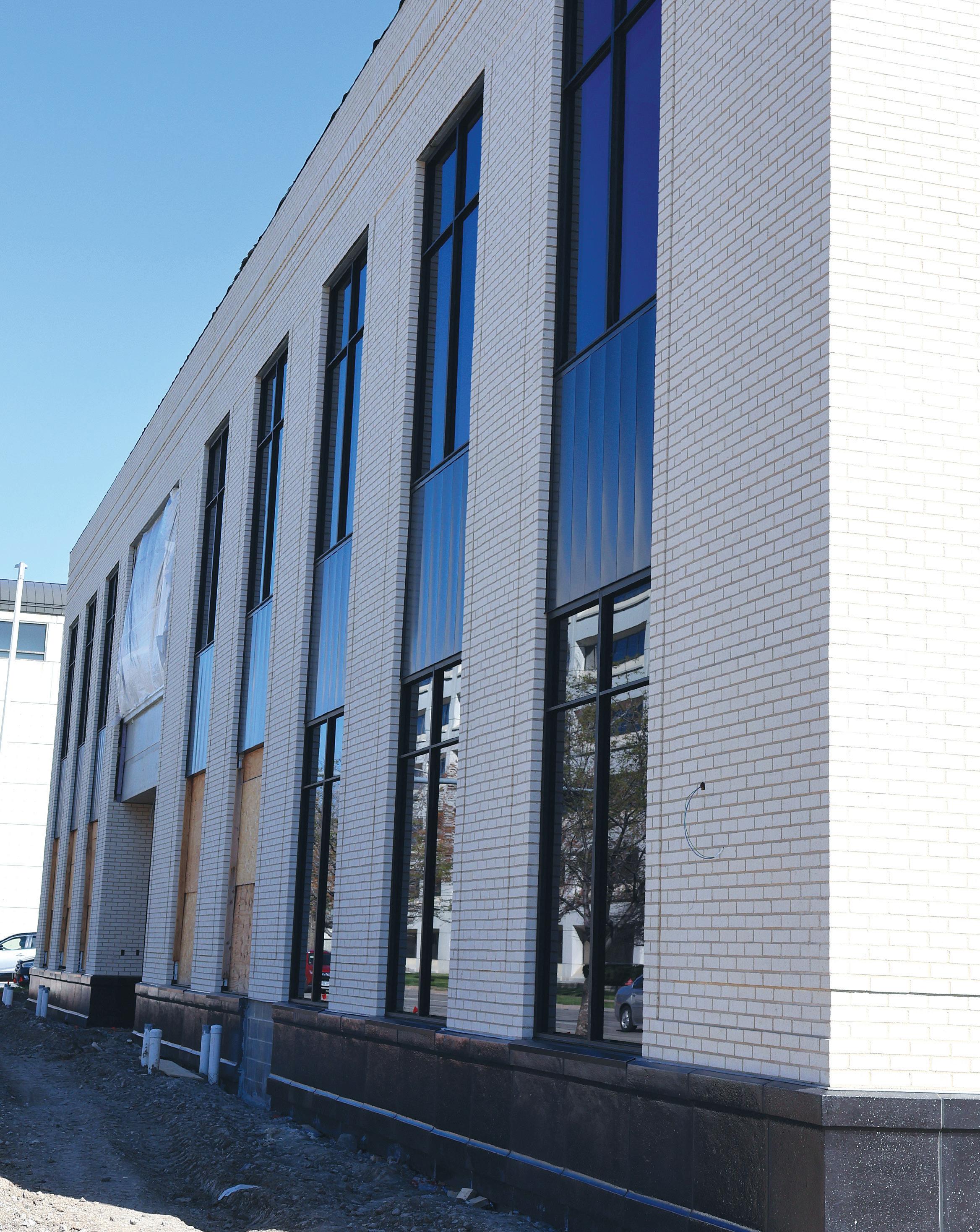

NEBRASKA MUNICIPAL REVIEW
NEBRASKA MUNICIPAL REVIEW
Youth create art to raise awareness for severe weather
Grand Island program involves immigrants in civic process
Alliance, Columbus, Fremont and others receive Creative District funding
Official Publication of the League of Nebraska Municipalities
APRIL 2025
The new League building: See more on page 7.


NEBRASKA MUNICIPAL REVIEW
The NEBRASKA MUNICIPAL REVIEW (ISSN 0028–1906) is published monthly and the official publication of the League of Nebraska Municipalities, an association of the cities and villages of Nebraska, published at 1335 L St., Lincoln, Nebraska 68508. Subscription rates are $5 per single copy — $50 plus tax for 12 issues. Periodicals postage paid at Lincoln, Nebraska. Views of contributors, solicited or unsolicited, are their own and not to be construed as having the endorsement of the League unless specifically and explicitly stated by the publisher
The NEBRASKA MUNICIPAL REVIEW is a nonprofit publication administered and supervised by the League of Nebraska Municipalities. All revenue derived from the publication is used by the association to defray publication costs.
League of NE Municipalities staff 402-476-2829 • www.lonm.org
L. Lynn Rex, Executive Director
Christy Abraham, Legal Counsel
Lash Chaffin, Utilities Section Director
Cherie DeFreece, Admin Assistant/ Membership Services Assistant
Brenda Henning, Membership Services Assistant
Ethan Nguyen, LNM/LARM Information Technology Manager
Shirley Riley, Membership Services Director
Jackson Sash, Utilities Field Representative/Training Coordinator
Ashley Wolfe, Marketing/Communications Director
LARM staff
Dave Bos, Executive Director
Tracy Juranek, Asst. Executive Director, Customer Service Specialist
Diane Becker, Communications/Marketing Director
Kyla Brockevelt, Executive Administrative Assistant
Drew Cook, Customer Service Specialist
John Hobbs, Loss Control Specialist
James Kelley, Loss Control Specialist
Fred Wiebelhaus, Loss Control/Claims Manager
POSTMASTER: SEND ADDRESS CHANGES TO NEBRASKA MUNICIPAL REVIEW, 206 S. 13TH ST., STE 800, LINCOLN, NEBRASKA 68508.
Have an idea, project or opinion to share? The League welcomes member articles, information, and op-eds.
Want to reach local decision makers? The League can help you get your message out to Nebraska’s 3,500+ municipal officials.To learn more, contact Ashley Wolfe at 402-476-2829 or ashleyw@lonm.org
President Marlin Seeman, Mayor, Aurora
President-Elect
Bryan Bequette, Mayor, Nebraska City
Vice President Joey Spellerberg, Mayor, Fremont
Past President Deb VanMatre, Former Mayor, Gibbon
Directors
Jean Stothert Mayor, Omaha
Leirion Gaylor Baird Mayor, Lincoln
Sharon Powell Village Board President, Utica
Jim Bulkley Mayor, Columbus
Betsy Vidlak Mayor, Scottsbluff
David Black Mayor, Papillion
Larry Evans Mayor, Minden
Rod Petersen Mayor, Louisville
David Scott City Manager, Sidney
Janine K. Schmidt
CMC/Treasurer, Morrill
Layne Groseth City Administrator/Utilities Manager, North Platte
Affiliated Sections
City Managers
Clerks
Munic. Accounting & Finance
Eric Melcher, Aurora
Tami L. Comte, David City
Becky Erdkamp, Exeter Fire Chiefs Dennis Thompson, North Platte
Utilities Pat Heath, Gering
What's inside?

Changing scenery 7
Features
Collaboration brings attention to severe weather, highlights work of young artists
AG Hilgers launches website focused on law enforcement recruitment in state
The new League building: A work in-progress
These mayors say climate is a kitchen-table issue - A working group of mayors believes climate resilience and economic security go hand in hand
NLC wants your story!
Nebraska lost $100 million in federal earmarks under stopgap funding bill
Grand Island program gives immigrants ‘crash course,’ nudges them to run on Election Day
CPAR releases report on the role of TIF in economic growth
Safe Streets grants now available
Arts Council awards nearly $1 million in Creative District grants to municipalities across state
DED announces 2025 CCCFF grant recipients
Columns
The Director's Message - L. Lynn Rex, LNM Executive Director - LB 647 (AM994): Please contact your Senator(s) ASAP and ask them to support AM994 to LB 647 with the emergency clause!
LARM - 30 years of proudly serving Nebraska communities
Bike Walk Nebraska - Trails transform: Revitalizing Nebraska communities with biking & walking
The Legal Corner by Nicholas J. Rock, Cline Williams Wright Johnson & Oldfather, L.L.P. - I-9 compliance in an era of renewed immigration scrutiny
USDA Rural Development - Improving community safety in rural Nebraska
On the cover
Photo of progress on the new League of Nebraska Municipalities building. Construction began last year and is scheduled to be complete in July 2025. Photo by Ashley Wolfe
Larger Cities Legislative Committee
John McGhehey, Mayor, Alliance
Seth Sorensen, City Manager, Alliance
Tobias Tempelmeyer, City Administrator, Beatrice
Rusty Hike, Mayor, Bellevue
Jim Ristow, City Administrator, Bellevue
Mindy Rump, Mayor, Blair
Phil Green City Administrator, Blair
Tom Menke, City Manager, Chadron
Jim Bulkley, Mayor, Columbus
Tara Vasicek, City Administrator, Columbus
Dave Bauer, Mayor Crete
Tom Ourada, City Administrator, Crete
Joey Spellerberg, Mayor, Fremont
Jody Sanders, City Administrator, Fremont
Kent Ewing, Mayor, Gering
Pat Heath, City Administrator, Gering
Laura McAloon, City Administrator, Grand Island
Mike Evans, Mayor, Gretna
Paula Dennison, City Administrator, Gretna
George Beckby, Mayor, Hastings
James Liffrig, Mayor, Holdrege
Chris Rector, City Administrator, Holdrege
Brenda Jensen, City Manager, Kearney
Brad DeMers, Asst. City Manager, Kearney
Doug Kindig, Mayor, La Vista
John Fagot, Mayor, Lexington
Joe Pepplitsch, City Manager, Lexington
Margaret Blatchford, Assistant City Attorney, Lincoln
Riley Slezak, Senior Advisor to the Mayor, Lincoln
Linda Taylor, Mayor, McCook
Nate Schneider, City Manager, McCook
Bryan Bequette, Mayor, Nebraska City
Perry Mader, City Administrator, Nebraska City
Andrew Colvin, City Administrator, Norfolk
Dani Myers-Noelle, City Attorney, Norfolk
Brandon Kelliher, Mayor, North Platte
Layne Groseth, City Admin./Utilities Manager, North Platte
Steve Krajewski, Mayor, Ogallala
Kevin Wilkins, City Manager, Ogallala
Thomas Warren, Chief of Staff, Omaha
David Black, Mayor, Papillion
Amber Powers, City Administrator, Papillion
R. Paul Lambert, Mayor, Plattsmouth
Emily Bausch, City Administrator, Plattsmouth
Don Groesser, Mayor, Ralston
Brian Kavanaugh, Council Member, Ralston
Art Lindberg, Mayor, Schuyler
Betsy Vidlak, Mayor, Scottsbluff
Kevin Spencer, City Manager, Scottsbluff
Joshua Eickmeier, Mayor, Seward
Greg Butcher, City Administrator, Seward
Brad Sherman, Mayor, Sidney
David Scott, City Manager, Sidney
Lance Hedquist, City Administrator, South Sioux City
Cale Giese, Mayor, Wayne
Jill Brodersen, Council President, Wayne
Wes Blecke, City Administrator, Wayne
Barry Redfern, Mayor, York
Dr. Sue Crawford, City Administrator, York
Smaller Cities Legislative Committee
Jessica Quady, City Administrator, Ashland
Marlin Seeman, Mayor, Aurora
Eric Melcher, City Administrator, Aurora
Chris Anderson, City Administrator, Central City
Andrew Lee, Admin/Clerk/Treasurer, Curtis
Tami Comte, Clerk/Treasurer/Interim City Admin, David City
Alan Michl, Chairperson, Exeter
Becky Erdkamp, Clerk/Treasurer, Exeter
Kyle Svec City Administrator, Geneva
Matt Smallcomb, City Administrator, Gibbon
Gary Greer, City Administrator, Gothenburg
Jana Tietjen, Clerk, Hebron
Barb Straub, Admin/Clerk/Treasurer, Hemingford
Kelly Oelke, City Administrator, Hickman
Janine K. Schmidt, CMC/Treasurer, Morrill
Sandra Schendt, Clerk/Treasurer, Nelson
David Russell, Director of Gov. Affairs, NMPP Energy
Mandy Hansen, Government Affairs Liason, NMPP Energy
Sandy Kruml Clerk/Treasurer, Ord
Mike Feeken, Mayor, St. Paul
Sandra Foote, Council Member, Superior
Jeff Hofaker, City Administrator, Sutton
Jessica Meyer, City Administrator, Syracuse
Sharon Powell, Village Board President, Utica
Kyle Arganbright, Mayor, Valentine
Melissa Harrell, City Administrator, Wahoo
Desiree Soloman, City Attorney, Waterloo
Stephanie Fisher, City Administrator, Waverly
Tom Goulette, City Admin./Utility Superintendent, West Point
Randy Woldt, Utilities Superintendent, Wisner
Robert Costa, Community Engagement Coordinator, Yutan

Municipal Legal Calendar
(All statute citations to Revised Statutes of Nebraska)
JUNE 2025
CITIES OF THE FIRST CLASS
• Within 10 working days following meeting or before next meeting (whichever is sooner) Clerk to have minutes available for public inspection. (84-1413)
• Within 15 days of Passage Clerk publishes ordinances passed. (16-405)
• As determined by the Mayor and Council - Board of Equalization meets. (16-707)
• Within 30 days following Council meeting Clerk publishes official proceedings of meetings, including claims. (19-1102)
• Within 20 days after end of month Treasurer files monthly financial report. (16-318)
• * * Clerk must prepare agenda prior to next Council meeting. (84-1411)
CITIES OF THE SECOND CLASS
• Within 10 working days following meeting or before next meeting (whichever is sooner) Clerk to have minutes available for public inspection. (84-1413)
• Within 15 days of Passage Clerk publishes or posts ordinances passed. (17-613)
• Within 30 days following Council meeting Clerk publishes official proceedings of meeting. (19-1102)
• Within 20 days after end of month Treasurer files monthly financial report. (17-606)
• * * Clerk must prepare agenda prior to next Council meeting. (84-1411)
VILLAGES
• Within 10 working days following meeting or before next meeting (whichever is sooner) Clerk to have minutes available for public inspection. (84-1413)
• Within 15 days of Passage Clerk publishes or posts ordinances passed. (17-613)
• Within 30 days following trustees’ meeting Clerk publishes official proceedings of meeting, including claims. (19-1102)
• Within 20 days after end of month Treasurer files monthly financial report. (17-606)
• * * Clerk must prepare agenda prior to next Board meeting. (84-1411)

Chaired by Mayor Don Groesser of Ralston
Chaired by Tom Goulette, City Administrator of West Point
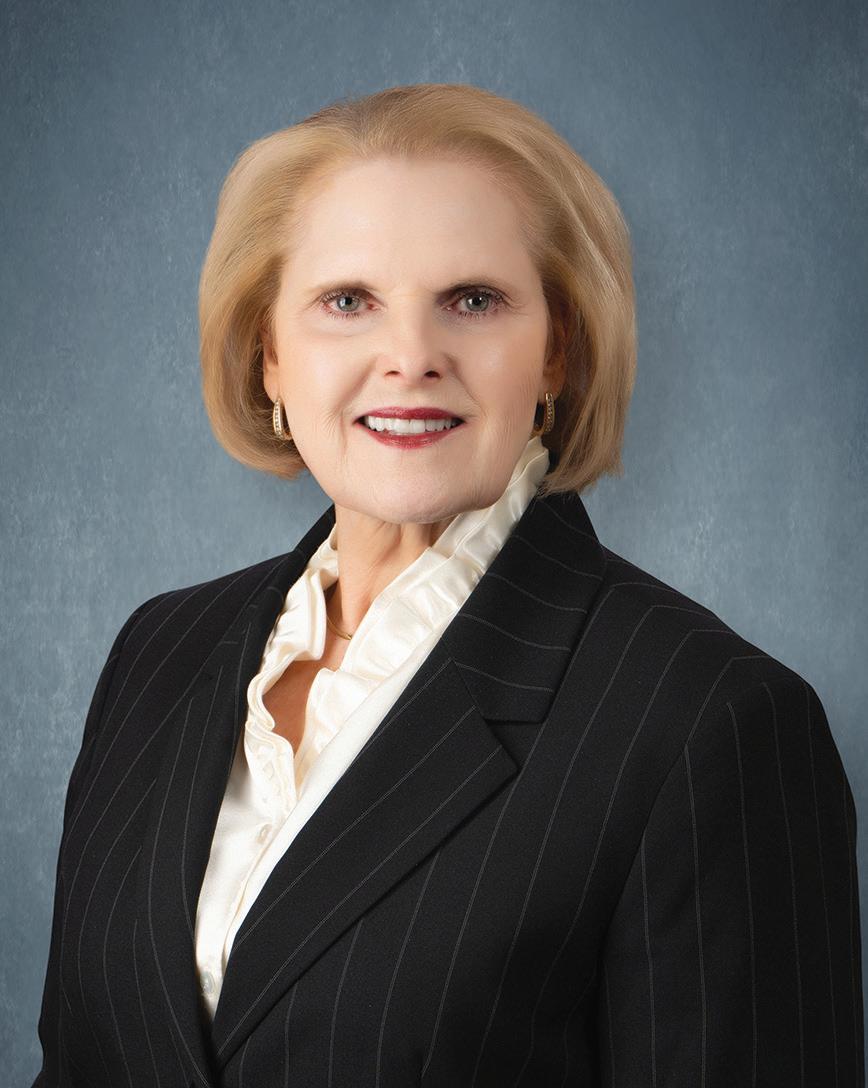
ThanksLB 647 (AM994): Please contact your Senator(s) ASAP and ask them to support AM994 to LB 647 with the emergency clause!
Revisions to the LB 34 property tax cap on municipalities and counties are needed to make it workable for your FY 25-26 budget!
BY L. LYNN REX, EXECUTIVE DIRECTOR, LNM
to Sen. Merv Riepe, primary introducer of LB 242, and Sens. Stan Clouse, Myron Dorn, and Mike Jacobson for cosigning on the bill which amends the Property Tax Growth Limitation Act adopted with passage of LB 34 in the 2024 Special Session which imposed property tax caps on municipalities and counties, effective July 1, 2025 The League’s highest priority bill is LB 242 (as amended by AM890), which the Revenue Committee incorporated by amendment into LB 647 (AM994) LB 647 (AM994) needs to pass this session with the emergency clause so the property tax cap is workable for your FY 25-26 budget!
Thanks to Sen. Brad von Gillern, Chair of the Revenue Committee, and Sen. Eliot Bostar, a member of the Revenue Committee, for negotiating with the League and NACO to make needed revisions to the “LB 34 property tax cap” on municipalities and counties, resulting in LB 242 (as amended by AM890) which was incorporated by amendment into LB 647 (AM994). Thanks to Sen. Brad von Gillern and Revenue Committee Members for advancing LB 647 to General File with AM994 on April 16.
Below are the key provisions of LB 647 (AM994) incorporating LB 242 (as amended by AM890) to amend the Property Tax Growth Limitation Act adopted with passage of LB 34 in the 2024 Special Session. Most of these provisions are technical or clarifying amendments to the Act consistent with the stated intent of LB 34; other revisions are needed to make the Act workable.
• Amends Section 13-518 to harmonize the definition of “allowable growth” in the “lid on restricted funds” with the definition of “ real growth value ” in the Property Tax Request Act (Pink Postcard statutes) and the definition of “growth value” in the Property Tax Growth Limitation Act (LB 34), including provisions
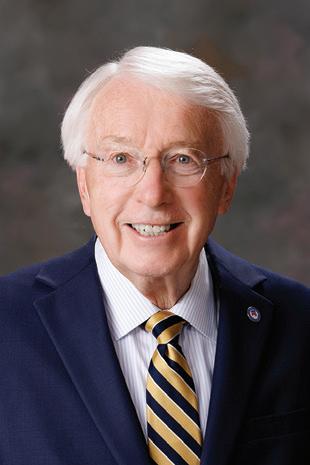
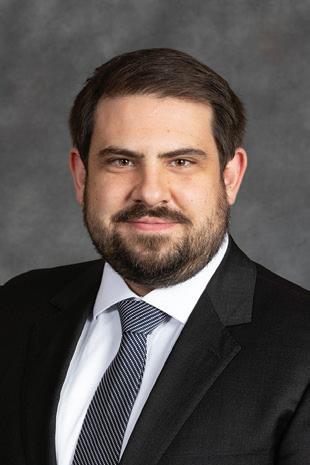
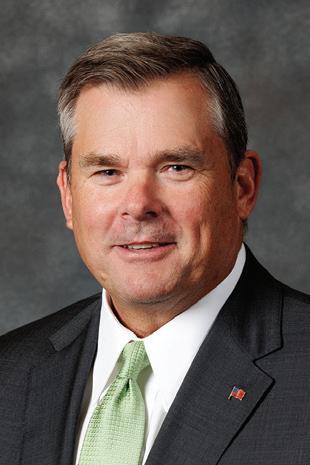
relating to tax increment financing. (Municipalities and counties will no longer be subject to the “lid on restricted funds,” effective July 1, 2025; however, other political subdivisions, except school districts, will remain subject to the “lid on restricted funds.”)
• Amends Section 13-3402 of the Property Tax Growth Limitation Act (LB 34) to harmonize the definition of “growth value” with the definition of “real growth value” in the Property Tax Request Act (Pink Postcard statutes) and the definition of “allowable growth” in the “lid on restricted funds,” including provisions relating to tax increment financing. Section 13-3402 also clarifies the definition of “inflation percentage.”
• Amends Section 13-3403 to clarify the formula for determining the property tax request authority in the Property Tax Growth Limitation Act (LB 34) allowing a political subdivision to take advantage of its “growth percentage” as intended in LB 34. (A harmonizing amendment (AM1098) is filed to LB 647 (AM994) on General File to strike the word “levied” and insert the words “requested and approved.”)
Sen. Merv Riepe District 12
Sen. Eliot Bostar District 29
Sen. R. Brad von Gillern District 4
• Amends Section 13-3405 of the Property Tax Growth Limitation Act (LB 34) by striking “the first Tuesday after the second Monday in an odd-numbered year” to allow for a special election to override the property tax cap beyond just “the first Tuesday after the second Monday in an odd-numbered year.”
• Amends Section 13-3406 of the Property Tax Growth Limitation Act (LB 34) to provide a transition for accumulating “unused restricted funds authority” under the “lid on restricted funds” to “unused property tax request authority” under the LB 34 cap, not exceeding 5% of the total property taxes levied for the political subdivision in calendar year 2024.
• Amends Section 14-109 for a Metropolitan Class City (Omaha) by deleting an occupation tax (OT) reference to Section 18-1208 eliminating the restriction on the amount of annual revenue that can be raised by a new OT or increased rate for an existing OT. (This section was supposed to be included in LB 34 passed in the 2024 Special Session.)
• Amends Section 15-202 for a Primary Class City (Lincoln) by deleting an OT reference to Section 18-1208 eliminating the restriction on the amount of annual revenue that can be raised by a new OT or increased rate for an existing OT. (This section was supposed to be included in LB 34 passed in the 2024 Special Session.)
• Amends Section 15-203 for a Primary Class City (Lincoln) by deleting an OT reference to Section 18-1208 eliminating the restriction on the amount of annual revenue that can be raised by a new OT or increased rate for an existing OT. (This section was supposed to be included in LB 34 passed in the 2024 Special Session.)
• Amends Section 16-205 for a First Class City by deleting an OT reference to Section 181208 eliminating the restriction on the amount of annual revenue that can be raised by a new OT or increased rate for an existing OT. (This section was supposed to be included in LB 34 passed in the 2024 Special Session.)
• Amends Section 17-525 for a Second Class City and Village by deleting an OT reference to Section 18-1208 eliminating the restriction on the amount of annual revenue that can be raised by a new OT or increased rate for an existing OT. (This Section was supposed to be included in LB 34 passed in the 2024 Special Session.)
• Amends Section 18-1208 to eliminate the restriction on the amount of annual revenue a municipality can generate by a new OT or increased rate for an existing OT. (This section was supposed to be included in LB 34 passed in the 2024 Special Session.)
• Amends Section 77-1631 of the Property Tax Request Act (Pink Postcard statutes) to harmonize the definition of “ real growth value ” with the amended definition of “ growth value ” in the Property Tax Growth Limitation Act (LB 34) and the amended definition of “ allowable growth value” in the “lid on restricted funds.”
• Amends Section 77-1701 to provide that the property tax statement that the County Treasurer sends to taxpayers shall indicate for each political subdivision the amount of property taxes due to fund any and all “public safety services” as defined in Section 13-320, county attorneys, and public defenders, regardless of whether such amount is taken as an exception to the political subdivision’s property tax request authority under Section 133404.
• Amends Section 77-7305 to clarify that the school district property tax relief is taking the PRIOR year credits but applying them to CURRENT year parcels. This removes the necessity of “creating” values for previously exempt properties, parcels that have been split, or parcels that have been combined. This section also clarifies that county treasurers are allowed to retain a 1% commission on credits they distribute. (This clarification to the Property Tax Growth Limitation Act (LB 34) is needed since there are competing interpretations from the State Auditor and the Department of Revenue.)
• AM 994 includes the repealer clause relating to LB 242 (as amended by AM890) which was incorporated into LB 647 (AM994). AM994 also includes the emergency clause since the LB 34 property tax cap enacted in the 2024 Special Session takes effect July 1, 2025.
• AM994 also incorporates the provisions of the following bills: LB 131 as amended; LB 242 as amended; LB 401 as amended; LB 628 as amended; and LB 709. The Revenue “Committee Statement” provides a brief summary of these bills which can be found on the Legislature’s website.
Thanks again for taking time to contact your Senator(s) ASAP about this important bill!

Collaboration brings attention to severe weather, highlights work of young artists
League President Marlin Seeman, Mayor of Aurora, helped select the winners of NEMA's poster contest announced on March 27 when Governor Jim Pillen signed a Proclamation in recognition of "Severe Weather Awareness Week." The League co-sponsored the poster competition.
Posters submitted from third graders across the state were judged based on "originality, effort and accuracy" with a clear message of weather safety preparedness. President Seeman presented a $50 check to the fourth place winner, Kora Nesbit from Two Springs Elementary School in Bellevue.




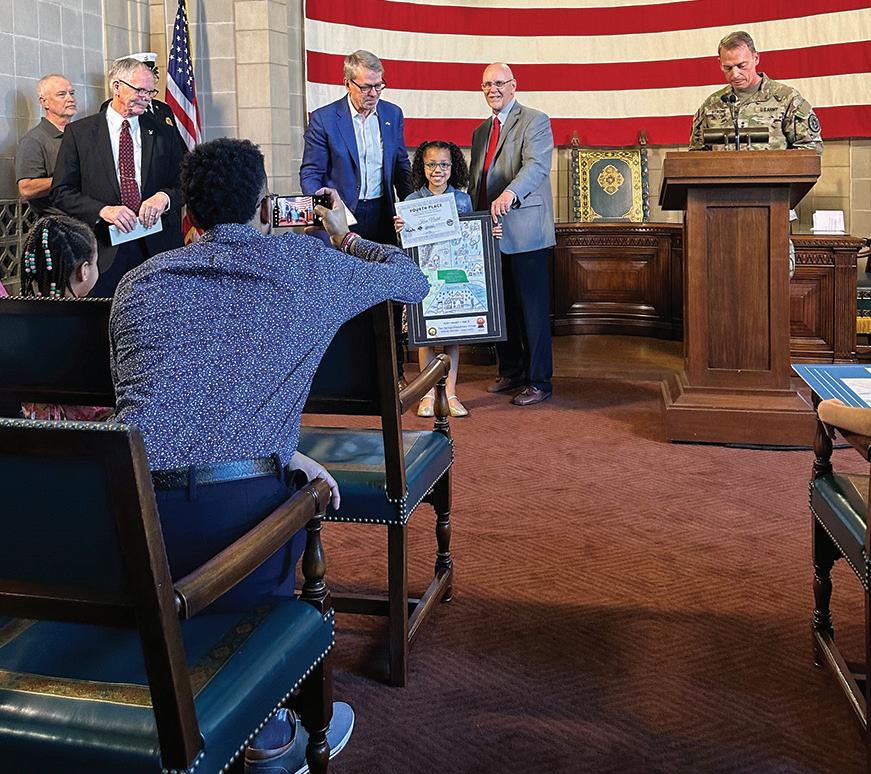
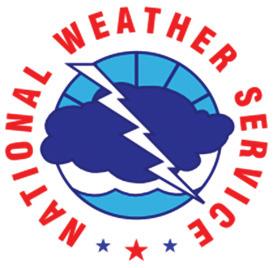

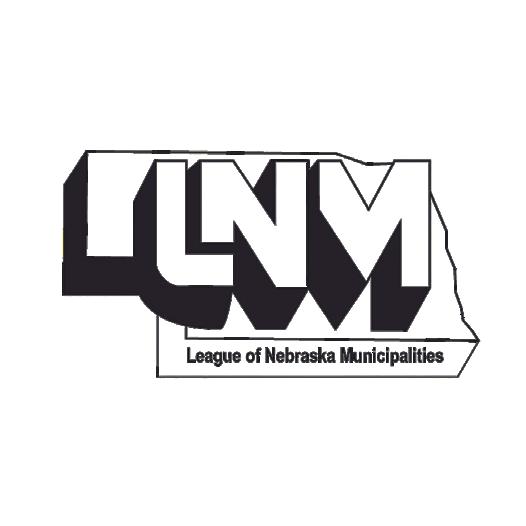
AG Hilgers launches website focused on law enforcement recruitment in state
Attorney General Mike Hilgers and leaders from across the state recently gathered in the Rotunda of the Capitol to unveil a new resource for Nebraskans. SecureTheGoodLife.Nebraska.gov is a new website designed to help recruit talent in law enforcement to the state.
Continued on page 26 / See Recruitment
Kora Nesbit, a student at Two Springs Elementary School in Bellevue, was presented with a $50 check for her poster submission.
The new League building:
A work in-progress


Photos from April 15, 2025, show the progress on the new League of Nebraska Municipalities offices. Completion is slated for the end of June.

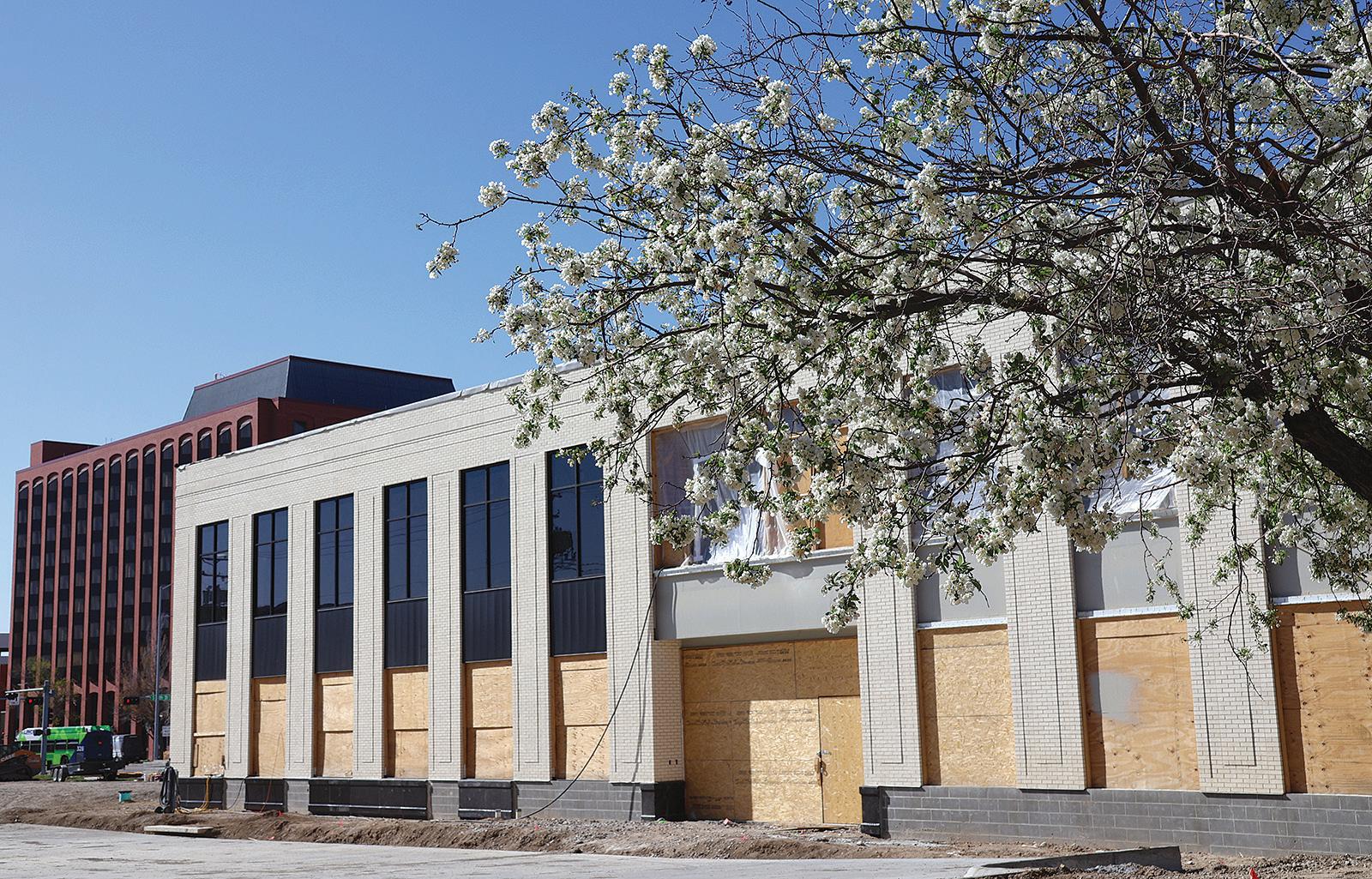
A few shots from



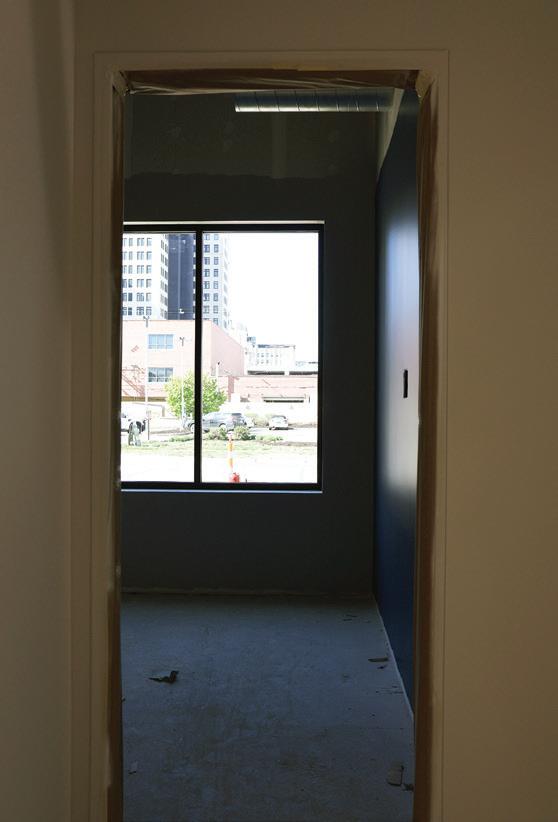
View of the new building
View of the new building from the parking lot
These mayors say climate is a kitchen-table issue
A working group of mayors believes climate resilience and economic security go hand in hand
BY CARL SMITH, GOVERNING.COM
In the months since President Donald Trump’s inauguration, federal policy has shifted away from climate mitigation and renewable energy investment. A group of mayors from around the country are making the case that climate action is essential to addressing something that’s top of mind for Americans: affordability. Mayors from cities in Tennessee, Nebraska, Idaho, Michigan, and Illinois are among the members of a Climate, Affordability, and Prosperity Working Group led by the bipartisan nonprofit Climate Mayors. They aim to highlight and share programs in their communities that lower costs and improve quality of life for residents by mitigating warming impacts. “It was important that we help link climate action with kitchen-table issues that mayors are dealing with when they’re thinking about ensuring their cities are vibrant, with opportunity today and into the future,” says the group’s vice-chair, Boise, Idaho, Mayor Lauren McLean. Nearly half of all Americans are “extremely” or “very” sure warming is real, but climate was last among 10 issues important to voters in a 2024 pre-election Pew Research Center survey. An overwhelming majority were most concerned about the economy, and events since January have only intensified their worries. For McLean and her colleagues, the paths forward for both issues are intertwined.
City of Trees
Mayors in the working group share the goal of making life more affordable for their residents, McLean says. Her city, the largest and fastest growing in the state, faces risks and costs from heat, drought, and wildfire. In recent years, it has experienced the hottest summers since recordkeeping began, with temperatures exceeding 100 degrees on 20 days or more. McLean has been mayor since 2020. That year, the city launched a “city of trees” challenge, setting a goal of planting a
forest seedling for every resident by 2030. It reached the goal in spring 2024 with the planting of the 235,000th seedling. The tree canopy saves residences $300,000 in energy costs and provides more than $3 million in air quality benefits each year, McLean says. The city is targeting neighborhoods that could still be considered “shade deserts” for more tree planting, using heat mapping to identify them. Zoning reform is another priority for McLean. Last year, the Boise City Council unanimously approved an updated zoning code. Among other changes, it allows for greater density along transit corridors and increases requirements for bicycle parking. These create possibilities for reducing transportation costs as well as emissions. Increasing the housing supply and making it accessible to transit and jobs are “making life better” solutions as well as climate solutions, McLean says. The point of the working group is for mayors to talk through things they are doing that meet both criteria, learn from one another, and imagine what more could be done.
Jobs and Resilience
In February, Lincoln, Neb., Mayor Leirion Gaylor Baird’s office announced a “Future-Ready Workforce” initiative offering scholarships for training that can help the city align job growth with a transition to clean energy. Interest accrued from American Rescue Plan funds will be used to pay for scholarships for training electricians; automotive technicians; and heating, ventilation and air conditioning technicians. The program will cover 100 percent of the costs of apprenticeships and training programs for these careers. Aligning economic development and “climate realities” is one of the primary goals of Lincoln’s climate action plan. Nebraska has 39 available workers for every 100 open jobs, Baird said at a press briefing on the goals for the
[The City of Lincoln] has announced a “Future-Ready Workforce” initiative offering scholarships for training that can help the city align job growth with a transition to clean energy.
working group. This exacerbates the challenges in recovering from climate events such as the tornado that damaged homes and businesses in Lincoln in 2024, or flooding it anticipates from a rise in heavy-precipitation days. Knoxville, Tenn., includes workforce development in its urban forest master plan. The city has set a goal of increasing tree canopy to 40 percent by 2040, in pursuit of benefits that include reducing heat stress, flooding risk, and air pollution as well as safety and better learning environments at its schools. The city has provided landscaper training and certification to help develop the workforce it needs to execute its plan and ensure trees survive well enough for their potential benefits to become reality.
Navigating Federal Shifts
Through its Greencorps program, the City of Chicago offers green job training to residents with barriers to employment, including criminal records — a type of program that has come under fire from the Trump administration in its push against diversity, equity, and inclusion. City, state, and private partners collaborate to provide learning opportunities and job placement for careers that include ecological restoration and green infrastructure. This opens the door for members of historically disinvested communities to share in economic benefits from the city’s work to build a green economy. The city is also supporting energy-efficiency upgrades and solar panel installation in these communities to bring down their utility costs, says Mayor Brandon Johnson, a member of the working group. Red and blue cities alike have made sustainability pledges based on funds promised to them by the federal government through the Inflation Reduction Act. Boise residents have asked McLean what she will do if grant funds are held back. She points to the 82 percent approval rate for a 2021 clean water and climate action bond as evidence that her community sees the connections between resilience, affordability, and quality of life. If funds don’t come at expected levels, she’s confident that philanthropy and partnerships with residents can fill gaps.
Working people are feeling anxiety and uncertainty amid a flurry of federal policy shifts.

The National League of Cities wants your stories! May is Mental Health Month and the organziation is launching a social media campaign focused on the topic.
NLC is seeking quotes and thoughts on why mental health is important from the municipal perspective and/ or how your municpality is supporting residents in your area.
If your quote is chosen for the campaign, NLC will be in touch to request a headshot.
Follow NLC on Facebook to see municipal officials from across the nation share their

“This is really about our economy,” said Johnson of the working group. “And already, this is an opportunity for Climate Mayors to provide some ease and a pathway forward to long-term sustainability.”
This article originally appeared on Governing.com on April 17. Reprinted with permission.

https://bit.ly/NLC-MH-Survey
Nebraska lost $100 million in federal earmarks under stopgap funding bill
BY ANDREW WEGLEY LINCOLN JOURNAL STAR
When U.S. lawmakers passed a stopgap funding bill in March to keep the government running through September, more than $100 million worth of federal earmarks that Sen. Deb Fischer seemed to have secured for Nebraska projects and communities vanished.
Fischer, Nebraska's senior U.S. Senator and a member of the powerful Senate Appropriations Committee, had requested millions for homestate projects that were included in the committee's budget bills, which Congress is supposed to pass on an annual basis to fund the U.S. government.
Lawmakers often have to turn to stopgap measures to avoid government shutdowns as they did in December and again earlier this month.
The stopgap funding bill, which House Republicans wrote and Congress passed, largely funds the government for the rest of the fiscal year at last year's levels, while cutting non-defense funding by roughly $13 billion.
The bill did not include any of the billions of dollars of funds that members of Congress had won for home-state projects — including millions of dollars Fischer had sought for the University of Nebraska system, the Native reservation in the northeast

The new National Center for Resilient and Regenerative Precision Agriculture, planned for this site at Nebraska Innovation Campus, will eventually house as many as 150 scientists as well as the staff to support them in two offices: the Agroecosystem Management Research Unit and the Wheat, Sorghum and Forage Research Unit. Earmarks that disappeared from the federal budget bill included a $32.5 million for university projects. Photo by Justin Wan, Lincoln Journal Star
part of the state that has been under a no-drink order for six years, and for infrastructure upgrades in dozens of rural communities.
In remarks to Lincoln business leaders in mid-March, Fischer said she would work to secure funding for the projects in next year’s budget, though there’s no guarantee the projects will be funded, particularly after the House last month passed a Republican budget resolution that calls for a $2 trillion reduction in federal spending over a decade.

Fischer lamented the loss of the earmarks, particularly $16 million she had secured for the U.S. Department of Agriculture research facility on Nebraska Innovation Campus and $8.25 million for water infrastructure upgrades on the Santee Sioux Nation reservation, where residents have been unable to drink or cook with their tap water for years.
“I was very upset that all that was taken out, because it’s something we — we have a tribe that doesn’t have drinking water. They have to bring in bottled water, and we had the solution to that,” she said last week. “So yeah, those things are upsetting. But we’ll work again this round with the appropriations bills and try to get all that in.”
Upset, too, are some of the university, village, law enforcement and tribal officials whose communities or agencies missed out on funding that, in many cases, they can’t get from any source but the federal government.
“Like Sen. Fischer, we’re disappointed, but we appreciate the work Congress
U.S. Sen. Deb Fischer
is doing to keep us moving forward,” said Mike Boehm, NU’s vice president for the Institute of Agriculture and Natural Resources, who said he’s not concerned about the future of the USDA research facility project.
“Occasionally, you get a year when you get a skip,” he said. “If we get two years of a skip, that’s another thing. Three years, then I’d start to get antsy. I’m not surprised by this.”
The earmarks Fischer had secured included a total $32.5 million for university projects, but most of the $101.76 million that was set to be sent to Nebraska was designated for infrastructure projects or public safety agencies, particularly in small towns.
Nebraska was poised to receive $20 million for upgrades at six municipal airports, including $5 million each for electrical improvements in Alliance and runway improvements in Blair.
The bygone Senate Appropriations bills also set aside $4.07 million for state law enforcement agencies, including $150,000 for a narcotics task force in Scotts Bluff County, $782,000 for 911 center upgrades in Beatrice and $1.1 million for new tasers and body-worn cameras for the Lancaster County Sheriff’s Office.
“We were excited,” said Ben Houchin, the Sheriff’s Office’s chief deputy. “Our budget’s about $18 million. So getting that kind of funding, it certainly helps, and it helps the taxpayers in Lancaster County.”
Now, he said, the Sheriff’s Office is deciding how to move forward. They could put in the same request with Fischer’s office for the next fiscal year, hope their bid makes it into the Senate Appropriations bill package again and hope Congress ultimately passes the spending bills. Or they could turn to the Lancaster County Board.
“So we’re kind of trying to figure out what we’re going to do,” Houchin said. “Our budget is coming up ... and we’ll work with the County Board. But as you can imagine, the budget’s probably going to be pretty tight this year.”
The vanished earmarks also designated $19.6 million for roads projects across Nebraska, including $5 million for a highway in Chadron, $4 million for two others in Fairbury and Red Cloud, and $3 million for road improvements in Garfield County.
The earmarks, too, were set to deliver $8 million for fire departments across the state, including $1.8 million for a new fire truck in Plattsmouth and $2.5 million for a new
fire hall in Clatonia, a Gage County village with about 260 residents, where officials said the old fire hall isn’t big enough to house the department’s newest ambulance, which hasn’t yet arrived from the manufacturer.
“It’s really hard for a village of 200 to finance a building that’s more like $2 million,” said Emily Haxby, who represents the village on the Gage County Board of Supervisors.
In addition to the fire hall, she said, Clatonia needs to install a second water well — a project that Fischer sought $637,000 for that ultimately wasn’t included in the Appropriation Committee’s spending package.
“The problem is, too: water is probably more of a necessity than a fire hall,” Haxby said. “And so if (the village is) going to finance anything, I would assume that you probably choose the water source first.”
She said building a new fire hall “would be next to impossible” without federal funds.
Nearly 15 percent of the earmarked funding Nebraska was set to receive — $13.9 million — was for water systems across the state, many of which were set to receive relatively small disbursements for tiny communities: $600,000 for lagoon improvements in Shelby, $225,000 for sewer rehabilitation work in Valparaiso, and $150,000 for water system upgrades in Oakdale.
In Greeley County, which was set to receive $1.3 million to build sewage lagoons that must be constructed with or without the federal aid, the village clerk said the village would now have to raise its sewage rate for the fourth time
Continued on page 12 / See Earmarks

The village of Santee’s water tank sits just outside the town. The Santee Sioux Reservation is currently under a no-drink order due to high levels of manganese in the water. Lincoln Journal Star file photo
Earmarks
Continued from page 11 in less than two years to $37.75. It was $23 at the start of last year.
“We were hoping we could go ahead and lower prices back down because inflation has been hard on everyone,” said Kennadi Dickes, the Greeley County clerk. “But we’re gonna have to increase now.”
In McCook, which was in line for $1 million to help with upkeep of its 20-year-old water treatment plant, Mayor Linda Taylor said she’s optimistic the town will receive federal funds next year.
“We’ve been proactive here in
McCook at looking at our water treatment facility, and we know it has to be upgraded,” she said. “And so we’re working toward next year. And so hopefully we don’t have that many more months to wait to get funded.”
In Santee, months of waiting have already turned to years.
Kameron Runnels, the vice chairman of the Santee Sioux Nation of Nebraska, said he’s hopeful Nebraska’s congressional delegation can secure money again next year to advance a pipeline project and restore clean drinking water to the reservation, where tap water contains manganese
above the EPA’s health advisory levels.
But after nearly six years of relying on bottled water to drink and cook with, he said, Runnels said it’s frustrating to face another year of waiting.
“Don’t forget about us,” Runnels said. “I know there’s big changes happening in D.C. and across the country, but we’re still smack dab in the middle of the country without clean water here, in what’s supposed to be the greatest and richest country in the history of the world.”
Reprinted by permission


GET A QUOTE AND JOIN TODAY!

The League Insurance Government Health Team (LIGHT) helps hundreds of its members throughout Nebraska obtain affordable health insurance coverage.
Plan and Network Choices
With seven plan options and three networks to choose from, you’re sure to find one that meets your group’s coverage and benefit needs.
Affordable Plan Options
Offering your employees much-needed protection against the high cost of medical care:
• Three PPO options
• Four HSA-eligible high deductible options
• Prescription drug coverage
Enrollment Options
Single: Covers the employee only
Employee and spouse: Covers the employee and their spouse
Employee and children: Covers the employee and their eligible dependent children, but does not provide coverage for the spouse
Family: Covers the employee and eligible dependents including a spouse
RECEIVE
Available Network Options
With several networks available, you have easy access to quality providers:
• NEtwork BLUE (Statewide)
• Premier Select BlueChoice (Regional)
• Blueprint Health (Regional)
• Out-of-state network availability
LET’S GET STARTED
Contact your current local Agent/Broker Or contact
Dennis Maggart
Executive Vice President P: 913-378-9841 or 816-718-0335
Dennis@McInnesGroup.com
Jane Limbach
Account Man ager P: 913-378-9840
Jane@McInnesGroup.com
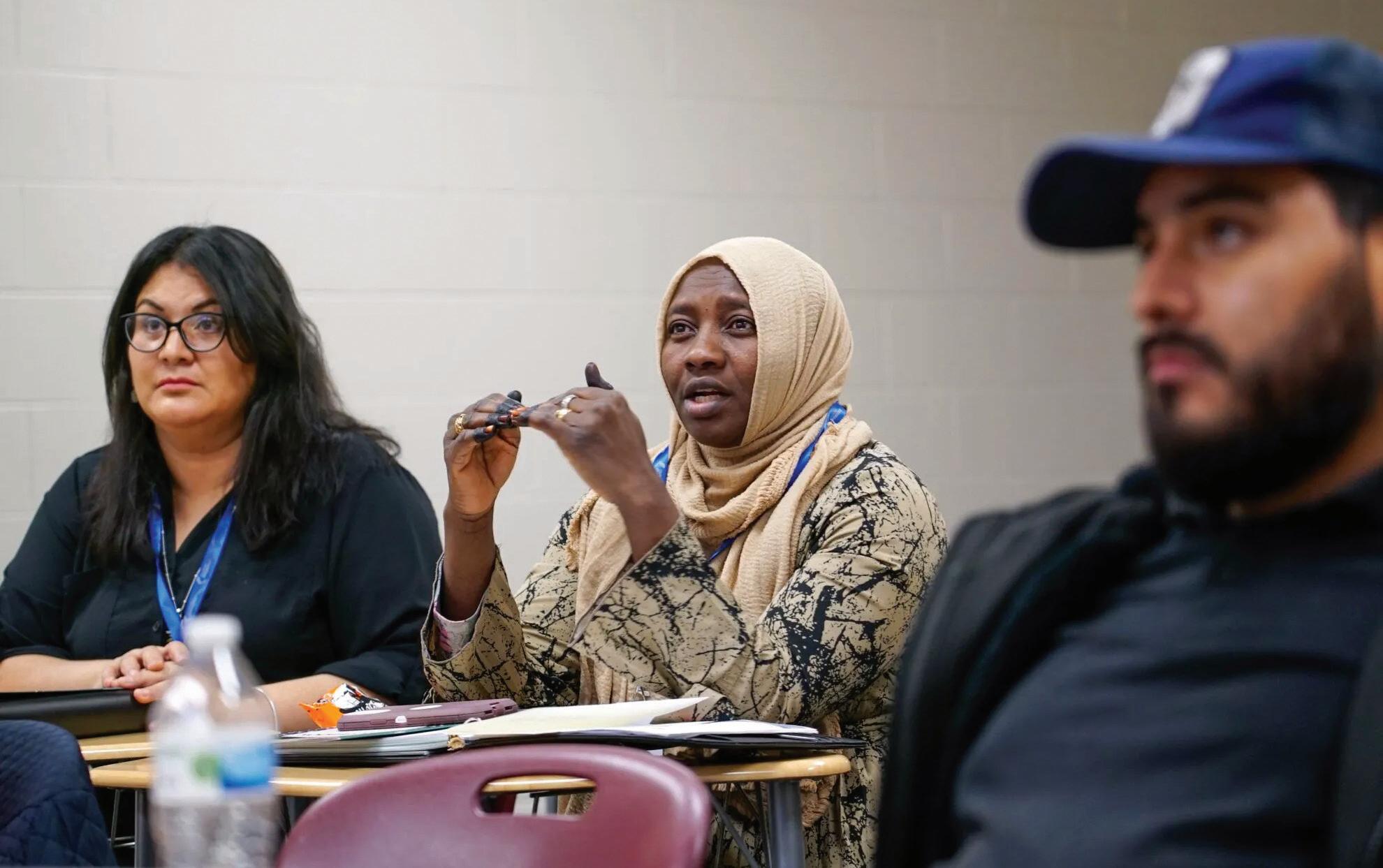
Grand Island program gives immigrants ‘crash course,’ nudges them to run on Election Day
In Grand Island, nearly 1 in 5 residents are foreign-born and 36% are people of color. An new program aims to help more immigrants plug into the city’s civic life, whether they have lived here for months or for decades. And leaders hope that some participants end up running for political office.
BY NATALIA ALAMDARI, FLATWATER FREE PRESS
Ekram
Saleh sat in a classroom, surrounded by immigrants from countries like Mexico, Guatemala, and Sudan. They listened as the county’s election commissioner talked about voting.
Here are your rights, the commissioner explained. Here’s how you can register. Here’s who represents your district on the city council. And also – our county, Hall County, needs poll workers to run every election.
Saleh was then a newly minted U.S. citizen, a Sudanese native who didn’t know that being a poll worker was a way she could serve her new country.
The next day, she went straight to the Department of Motor Vehicles and signed up to be an election volunteer. In her first election, she both helped as a poll worker – and voted, too.
That’s a story you hear around the offices of Elevate Grand Island, a leadership program geared towards this central Nebraska city’s growing and increasingly diverse immigrant population.
Think of Elevate as a crash course in getting to know your city – learning your voting rights, connecting with local nonprofits, meeting first responders and police leaders.
The hope is that it’s helping Grand Island’s immigrant communities become more civically engaged, much like Saleh did during the 2022 Election.
That they’ll grow professionally. That they’ll feel welcome. Feel they belong here.
The ultimate goal: That they’ll feel emboldened to run for public office, and if elected, help make Grand Island’s board
Ekram Saleh speaks during a weekly session of Elevate Grand Island, a leadership program for immigrants living in the central Nebraska city. Through Elevate, Saleh learned about being a poll worker and has volunteered in three elections. Photo provided.
and councils look more like the city they represent.
Grand Island is now 36% people of color, and 18.5% foreign-born.
The city of 52,944 has not, to this point, elected a mayor who is a person of color.
The only people of color currently holding any elected office in the city are believed to be two Latino school board members, Eric Garcia-Mendez and Carlos Barcenas, they said, after Sen. Ray Aguilar narrowly lost re-election to the Nebraska Legislature.
“It’s not rocket science, right? We’re just getting people connected and resourced,” Garcia-Mendez said. “But it’s kind of life-changing for a lot of participants…We are deciding to include and value community members who have historically just been left in the dark.”
The idea of Elevate began during the pandemic, when workers at Heartland United Way realized there was no leadership program specifically for immigrants in Grand Island. They looked to a similar program in Lincoln as inspiration, and asked the Grand Island nonprofit Leadership Unlimited if it could take on another professional development program –a condensed, 7-week course tailored to the immigrant experience.
Elevate provides childcare during the weekly sessions to make it easier to attend. The program is free. It’s designed to be open to any foreignborn Grand Islander, regardless of whether they have lived in the country for a few months or 25 years.
The application doesn’t ask immigration status.
Potential donors questioned that decision, said Jessica Hendricks, executive director of Leadership Unlimited.
“We don’t ask for any of our other programs,” she said. “Why would we
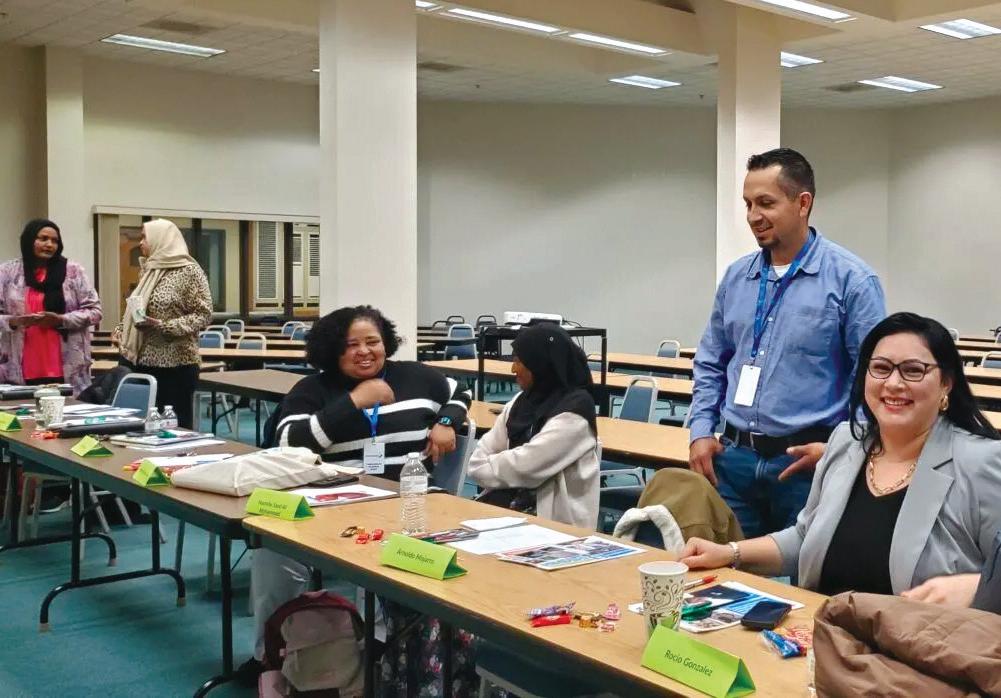
Elevate Grand Island participants talk between presentations during their weekly meetings. After completing the program, participants get a $1,000 scholarship to spend on whatever professional development they want to pursue. Photo provided.
“
It’s not rocket science, right? We’re just getting people connected and resourced. But it’s kind of life-changing for a lot of participants…We are deciding to include and value community members who have historically just been left in the dark.
”
ask for this one? Just come as you are. Come learn.”
The first cohort started in 2022. Since then, Grand Island residents hailing from 12 countries have participated.
Some of these countries are war-torn and poverty stricken. Some of the participants are caught in immigration red tape and desperately hoping to gain citizenship.
But in this classroom, the outside chaos of the world seems to fade, said Maria Vasquez, the program’s director.
On a recent Tuesday, immigrants from countries like Mexico, the Philippines, Somalia, and Cuba sit at long classroom tables, folded name tents before each of them.
They learn about banking and credit
- Eric
Garcia-Mendez
scores. They talk through the details of retirement plans and 401(k)s. They discuss business plans and loan applications, their dreams of starting clothing shops and getting into real estate.
“We are all affected by what’s going on outside of those doors, but the moment we come into that room, it’s almost like none of that exists,” Vasquez said. “We can create our own world where we are kind to each other, we are respectful of each other’s cultures.”
When they finish the program, participants get a $1,000 scholarship to use on professional development.
Continued on page 20 / See Immigrants
CPAR releases report on the role of TIF in economic growth
The Greater Omaha Chamber, in collaboration with the University of Nebraska at Omaha’s Center for Public Affairs Research (CPAR), has released a comprehensive report on the role of Tax Increment Financing (TIF) in fostering economic growth across Nebraska. The results underscore how TIF has transformed blighted areas and contributed to property value increases and community revitalization throughout the state.
TIF is a critical economic development tool for Nebraska. This report confirms what we’ve long believed: that strategic investments in TIF not only attract private development but also create long-term economic benefits for Nebraska’s communities. We will continue to utilize this essential tool knowing that it is indispensable for attracting investment and creating vibrant, economically resilient communities.
”
- Heath Mello, President & CEO of the Greater Omaha Chamber
Key findings of the report:
TIF is actively used in 67 out of Nebraska's 93 counties, spanning 136 cities and villages. Projects funded by TIF have supported residential development (54% of projects), commercial growth, industrial site creation, and essential public infrastructure improvements.
Property valuations in all active TIF areas have increased, with a total valuation growth of 324% since their base assessment. Adjacent areas have also seen average valuation increases of 19.5%.
TIF has spurred redevelopment that improves housing availability, modernizes infrastructure, and revitalizes communities across the state.
The report highlights how TIF addresses key challenges facing Nebraska, including population stagnation and the need for infrastructure improvements. By leveraging future property tax revenue, TIF enables municipalities to fund critical development projects without immediate tax increases or reliance on state and federal grants.

“Our research demonstrates that TIF not only revitalizes key areas but also produces measurable economic benefits that extend beyond the immediate project boundaries. This report provides evidence that TIF remains a pivotal tool for Nebraska’s continued economic development and community revitalization,” said Dr. Josie Schafer, CPAR director.


Source - City of Omaha
Safe Streets grants now available
In late March, President Trump’s new Administration released their first Notice of Funding Opportunity (NOFO) for the popular Safe Streets and Roads for All (SS4A) program. So far, SS4A has provided $2.9 billion in federal funding to over 1,600 communities in all 50 states and Puerto Rico.
The purpose of SS4A grants is to improve roadway safety by significantly reducing or eliminating roadway fatalities and serious injuries through the development of Action Plans and refinement and implementation focused on all users, including pedestrians, bicyclists, public transportation users, motorists, and commercial vehicle operators.
Grant options available 1.
• Planning and Demonstration Grants are used to develop, complete or supplement an Action Plan, as well as carry out demonstration activities that inform an Action Plan. In this funding round, there is just over $402 million available for Planning and Demonstration Grants. Funding ranges are $100,000 to $5,000,000.
• Implementation Grants are used to implement strategies or projects that are consistent with an existing Action Plan and may also bundle funding requests for supplemental planning and demonstration activities that inform the Action Plan. There is $580 million available for Implementation Grants and those awards will be between $2,500,000 to $25,000,000.
3.
Key grant dates
May 9: There is also a chance for pre-application eligibility review for implementation grants. If you would like your implementation grant reviewed, it must be submitted by May 9, 2025, to USDOT.
May 29: As you build your grant if any technical questions arise, they must be submitted to USDOT by May 29, 2025.
June 26 at 5 PM EST: Deadline to apply but always try to plan to submit at least one day prior!
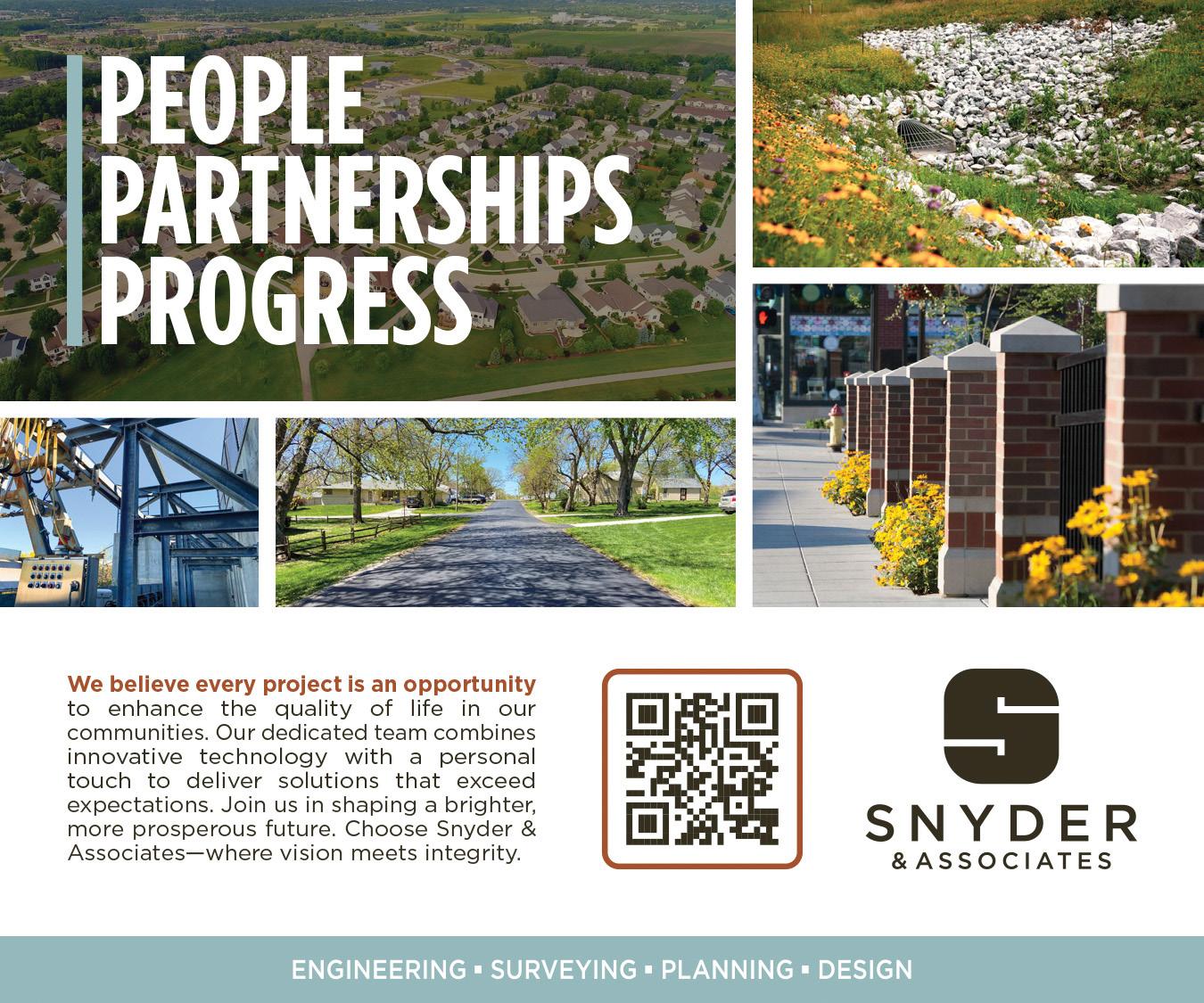
Local projects eligible for support
Eligible activities with SS4A grants include both grants for planning projects and for infrastructure projects:
2.
• Develop a comprehensive safety action plan (Action Plan).
• Conduct supplemental safety planning to enhance an Action Plan.
• Carry out demonstration activities to inform the development of, or an update to, an Action Plan.
• Perform planning, design and development activities for projects and strategies identified in an Action Plan.
• Implement projects and strategies identified in an Action Plan that address roadway safety problems. Successful grant applications will:
• Promote safety to prevent fatal and serious injuries on public roadways.
• Employ low-cost, high-impact strategies that can improve safety over a wide geographic area.
• Ensure equitable investment in the safety needs of underserved communities.
• Incorporate evidence-based projects and strategies and adopt innovative technologies and strategies.
• Demonstrate engagement with a variety of stakeholders.
• Follow Americans with Disabilities Act (ADA) to make facilities accessible to the maximum extent feasible.
• Support the creation of quality jobs.
• Align with principles from the DOT Order, Ensuring Reliance Upon Sound Economic Analysis in DOT’s Policies, Programs and Activities.
Source - National League of Cities
30 years
of proudly serving Nebraska communities
The League Association of Risk Management (better known as LARM) is celebrating its 30th anniversary of pooling in 2025. We are proud that over 235 Nebraska governmental entities trust us with their risk across the state, the League created a risk management pool in which governmental entities could pool their funds together and selfinsure. LARM was formed and began operations in 1989 as an endorsed insurance program that
included risk management services for municipalities.
LARM received its official pooling certificate from the State of Nebraska in 1995 with 13 municipalities as members. At that time, LARM operated as a property and liability group self-insurance pool. In 1997, LARM began offering workers’ compensation, and the pool started growing. By 2014 there were 67 members, and at the end of 2024, there were 235 LARM members from across the state.
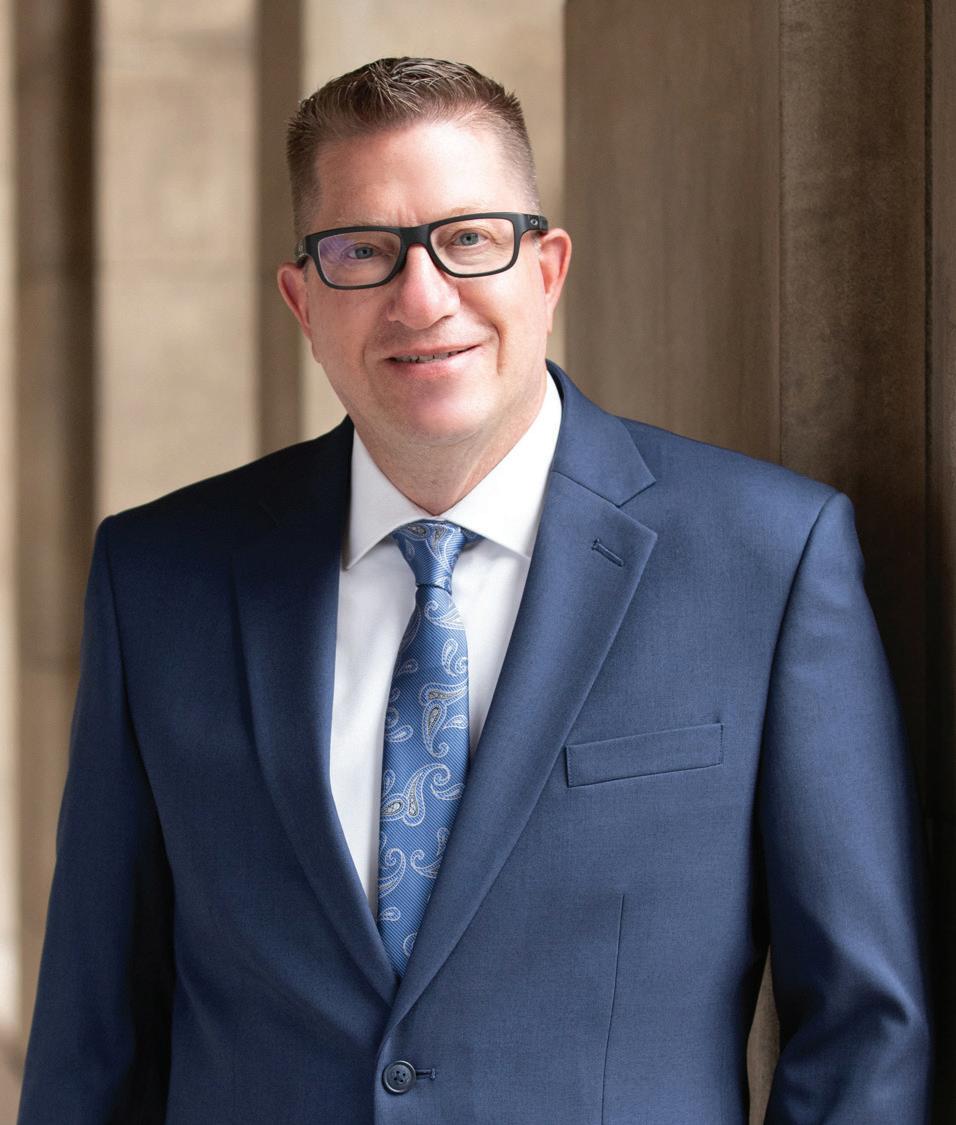
DAVE BOS EXECUTIVE DIRECTOR, LARM

LARM is governed by 15 board members made up of elected and appointed officials chosen at an annual meeting by the LARM membership. There are eight fulltime LARM staff members, with the main office located in Lincoln. Our board members and staff are very proud of LARM’s reputation for excellent customer service as we put a very high priority on assisting our members with every aspect of their risk management and insurance needs. LARM also takes pride in providing top-notch loss control, claims, and valuation services. We are always only a phone call away if a member has any questions about a claim or their coverage.
LARM is not a traditional insurance company, and we make getting to know our members
a priority, which allows us to better anticipate their needs and assist them in any way we can. For example, in 2018, we started offering a $500 Lean on LARM safety grant each year for members to purchase items like barricades, first aid kits, and gas monitors to help make their employees and communities safer. We have received many positive stories about how items purchased with the use of these grant funds have assisted in reducing or preventing innumerable injuries, property losses, workers’ compensation claims, and liability claims.
In 2019, LARM created the LARM Armor grant that provides $700 each year towards the purchase of body armor for member police departments. When floods hammered the state in the spring of 2019, LARM offered $1,000 to members who had their offices, streets, and parks damaged by flood waters. No one will soon forget when COVID-19 was widespread in our
Continued on page 21 / See LARM
Arts Council awards nearly $1 million in Creative District grants to municipalities across state
Congratulations to all municipalities recently awarded the 2025 Development Grants for Nebraska Creative Districts by the Nebraska Arts Council.
The grants are available to all certified Creative Districts with the purpose to provide funds for projects that focus on significant cultural tourism and economic development. Projects supported by the funds must demonstrate the potential to draw visitors, create jobs, attract or retain young people, and revitalize Nebraska communities.
Applications for the nearly $1 million in grants came from 24 Creative Districts across the state.
Some of the projects made possible by this grant program include the renovation of the Heart City Theater in Valentine, a mural festival at Carhenge in Alliance, improvements to outdoor performance spaces in Holdrege, and the creation of a movable stage that will be shared between Sidney and Potter. The
Alliance Creative District:
Grantees
Columbus Creative District:
Fremont Creative District: Heart City Creative District (Valentine): Iron Horse Arts District (Holdrege): McCook Creative District:
Open Frontier Creative District (Chadron):
Sidney Creative District: Western Trails Creative District (Ogallala): York Creative District:
$100,000 $100,000 $100,000 $100,000 $100,000 $100,000 $100,000 $100,000 $100,000 $95,630
projects planned will have a significant impact on their districts in terms of job growth and tourism development.
“We’re excited to support the Creative Districts and see the economic growth these projects will bring to their communities,” reports Rachel Morgan, Program Specialist at the Nebraska Arts Council.
The Nebraska Creative District Program was created through legislation in 2020 to utilize the arts as an economic driver to support communities in Nebraska by telling their stories and elevating the value of the arts. Creative Districts are designated cultural and economic areas where innovation flourishes and neighborhoods come together in the name of art. They provide significant economic impact by creating purposeful spaces like art galleries, theatres, and music venues.
Source – Nebraska Arts Council

This place…has always been inhabited by immigrants. And that seems to be forgotten.” “
- Chris Hochstetler Executive Director, Stuhr Museum
Immigrants
Continued from page 15
“We’ve had people ask, ‘Well, can I put this towards my kids’ college?’”
Hendricks said. “No. It’s not for them. It’s for you. I want you to continue down this path of…personal advancement.”
One participant, a doctor in his home country, used the money to complete medical certifications in the United States. Another finished her business degree.
Before, she worked in a school cafeteria. Now she works at the bank, teaching finance classes in Spanish. **
Elevate Grand Island always starts with a history lesson.
“This place…has always been inhabited by immigrants,” said Chris Hochstetler, executive director of the Stuhr Museum.
“And that seems to be forgotten.”
Hochstetler takes each class as far back as the region’s first inhabitants – the Pawnee, who migrated here from the Mississippi River Valley.
He tells them about the German settlers who founded Grand Island in 1857. Shortly after came a wave of Latino and Japanese immigrants, pulled here by the railroad, sugar beet factories and cattle. The museum has records of ranching cowboys from Senegal.
“It’s not like people just came here by accident. They were actively recruited across the world to come here and work those blue collar jobs,” Hochstetler said. “I tell them a bit about that story so that folks can understand that this is not something that is isolated to their experience. It’s something that has been going on in our community since 1857.”
Hochstetler’s history lesson often brings participants to tears. One woman said
she’d lived in Grand Island for 20 years, and didn’t feel fully connected until learning its long immigrant history.
Melissa Zurcher, an immigrant from Mexico, said it still gives her chills to think about it.
“When you come here from another country, you don’t feel a part of the (new) country,” Zurcher said. “That first presentation…touched my heart. You feel like I’m a part of something. Not just right now, but from history.”
Carlos Barcenas, who sits on the school board for Grand Island Public Schools, said it sometimes takes decades for an immigrant to feel comfortable and confident enough to start participating in the city’s civic and political life. Barcenas came to Grand Island as a firstgeneration immigrant from Mexico 30 years ago. He senses the city changing.
“We have more and more people that are serving on boards that are bilingual,” Barcenas said. “There are a lot of people who are very involved, whether it’s a PTO, or they’re a board member at a nonprofit, or a committee. They’re there. It’s just not such a public position.”
But it’s those public elected positions that Hendricks hopes Elevate participants will run for one day.
Grand Island doesn’t track the racial identity of its city council members. But a review of council rosters since 1998 shows only one Latino member – Jose Zapata – besides Aguilar’s short stint on the council after being appointed in 1996.
Aguilar was also Grand Island’s first and thus far only Latino state senator. He served a total of 15 years in the Legislature before being ousted in November 2024 by Dan Quick, a white
Democrat from Grand Island. Aguilar could not be reached for comment.
In Grand Island Public Schools – a district that’s 67% students of color – there are two Latino members on a nine-member board.
Barcenas was the first Latino elected to that board when he ran in 2012, he said. Garcia-Mendez, the child of Guatemalan and Mexican immigrants, became the second.
Garcia-Mendez said his experience mirrors that of many Grand Island students. Spanish-speaking parents are more comfortable seeking help from a board member who speaks Spanish. They’re often surprised to see a young Latino man on the board, he said.
Electing a wide range of backgrounds and experiences makes a board more effective, Barcenas said.
“As a board member, do I represent only my Mexican immigrants? I don’t. I represent the people in my ward,” Barcenas said. “It goes beyond ethnicity… It’s a line of having a diversity of thought, having intercultural competence. And just knowing who’s in your community.”
But hurdles can keep first-generation immigrants from running for office, like language barriers and learning a new government system and how public meetings are run, he said. The time commitment and hours of work for either a small stipend or no pay can deter working parents from running as well.
Grand Island reflects national trends – a Harvard University study this year found that people of color are drastically underrepresented in local government. While city council members tend to be slightly more diverse, local elected officials are generally whiter than their communities.
“We’re really trying to empower and build leaders in our community that come from all over, and that can represent all of the demographics here in Grand Island,” Vasquez said. So far, no Elevate participants have run for office. But they have been inspired to get involved in their community in other ways.
Since participating in Elevate, Zurcher started her own business, and opened a storefront selling charcuterie boards and sandwiches. She wants to create flexible jobs for other moms with small kids.
Naily Mhadji-Issa came to Nebraska feeling sad and isolated, far from her home in France. Elevate helped her meet other immigrant moms.
She and other Elevate participants have pulled together a group of about 15 African moms who get together every month. She’s on multiple boards throughout Grand Island. And she tells everyone they should apply for Elevate.
“Even the cashier at Walmart,” she said. “It should be mandatory. Everybody should do that when you come to America.”
Saleh has now volunteered as a poll worker in three elections. She helps translate for Arabic speakers, and tells her friends, go vote, I’ll be there. I can help.
I don’t know what I would do if you weren’t here,” one voter told her.
She’s convinced three other friends –all Sudanese and Arabic speakers – to volunteer at the polls. And she’s not sure when. But one day she wants to run for office.
The Flatwater Free Press is Nebraska’s first independent, nonprofit newsroom focused on investigations and feature stories that matter. Learn more at flatwaterfreepress.org
LARM
Continued from page 18
communities. During the pandemic, LARM created a program that offered $120 a day for 10 days for any individual volunteer fire or EMT member who had to stay home due to quarantine requirements after being exposed to the virus on an emergency call.
On a daily basis, LARM loss control specialists travel the state, assisting members with safety training and giving them resources for their staff. We regularly send our members safety articles and newsletters and provide free in-house training on safety topics as needed or requested.
LARM continues to grow. In 2023, we added 18 new members, and we welcomed another 21 new members in 2024. We also retain our members.
In the last 10 years, we’ve had a retention rate of 99%. New members often mention that the reason they looked into LARM is because of the great things they had heard about us from their neighboring communities.
Speaking on behalf of all LARM staff, we are very thankful to be able to provide the risk management and insurance services needed for so many Nebraska communities these past 30 years and we look forward to providing them with the same top-notch coverages, competitive pricing, outstanding customer, claims, loss control, and valuation services for many more years to come.
Engineering a world where everyone thrives.

Trails transform:
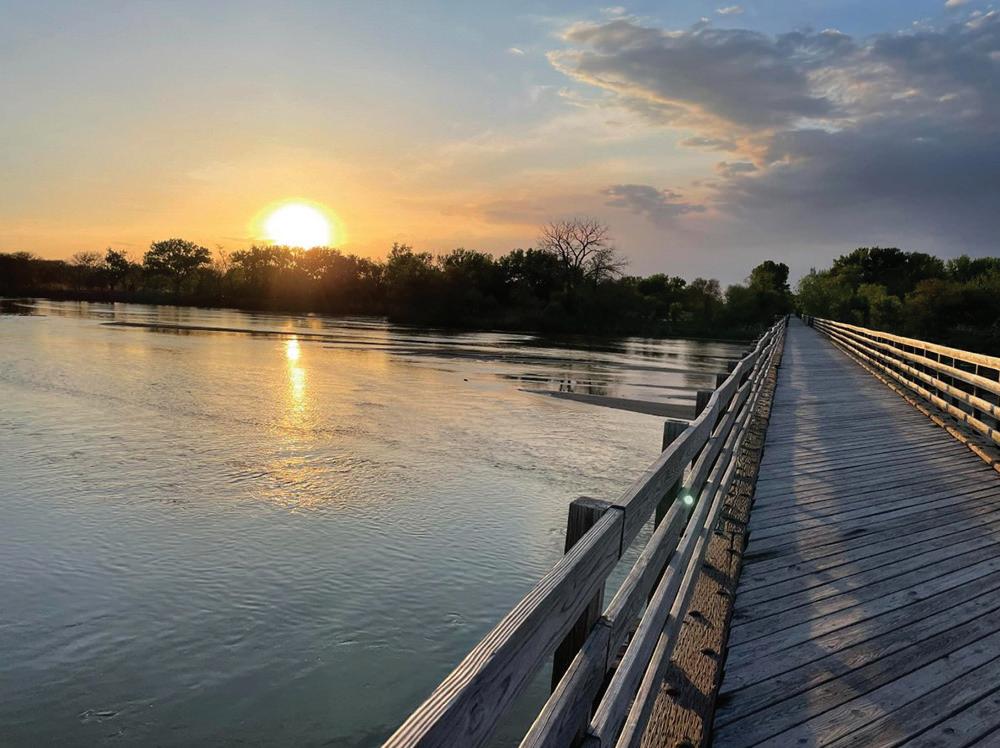
Revitalizing Nebraska communities with biking & walking
Trails are easily the topic we field the most questions about at Bike Walk Nebraska.
We aren’t alone. The Statewide Comprehensive Outdoor Recreation Plan (SCORP) found trails to not only be one of the most used amenities in the state, but also the top amenity Nebraskans think is important to have and would like to see more of.
In short, Nebraskans use trails and want more of them.
Trails have the power to transform our Nebraska communities through tourism, economic development, small business support, and job creation. You can look just over the border to the Wabash Trace Trail in Iowa to see single-road towns with thriving downtown districts, farmers’ markets, and even a bike shop - due in part to the trail running by their community.
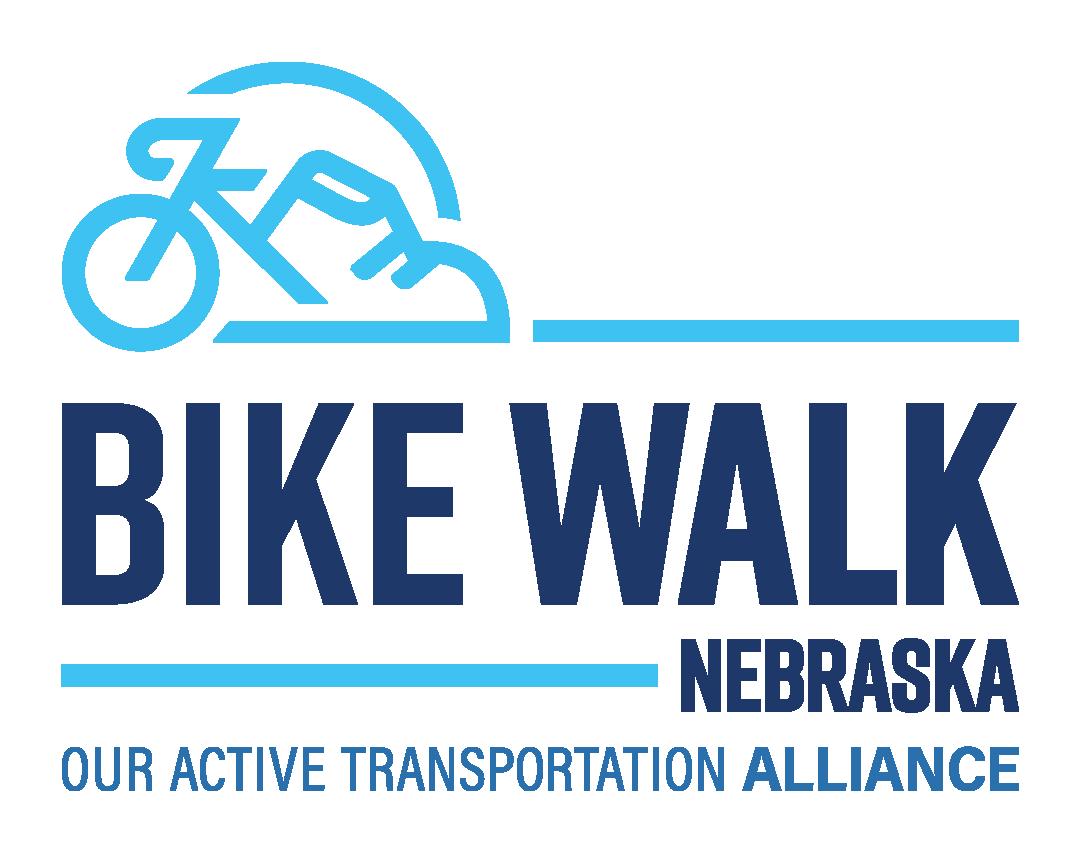
Making the Case for Trails
At Bike Walk Nebraska, we lean into statistics to support our work, so here are some of my favorites showcasing the power of trails in a community:
• It’s been shown that with every dollar spent on trails, there’s over a 400% return.
• Bicyclists are known to spend 5x more with businesses than someone arriving via a car.
• Properties along trails are starting to be likened to beach-front properties, with upwards of a 150% increase in value.
The benefits of a trail quickly compound, whether it’s job retention and creation, tourism and economic
development, or public health and safety.
But it’s about more than the statistics - it’s about connecting a community. Planning a trail with connections to the businesses, residents, and key points of interestlike an aquacourt, park, or school - gives local residents a deeper sense of belonging. Connectivity is key.
Common Trail Myths
With every trail conversation, comes a set of common myths we are well-suited to dispel.
First, we often hear worries about increased access via trails bringing an increase in crime or trespassing. There is no data to support a correlation between trails and crime, and considering that roads and sidewalks often exist in these areas, it’s unlikely that would-be criminals will flock to a trail system.
The second most common myth we address is the concern of nobody using the trail. Infrastructure is a “build it, and they will come” investment.
Most U.S. adults (about 60%) would choose to bike and
Continued on page 23 / See Trails
The Dark Island Trail
Continued from page 22
walk more if they had access to a safe space away from traffic. And, I would be remiss as a transportation advocate if I didn’t mention that the more intentionally you plan for your trail to support recreation and transportation, the higher the return on your investment because it will encourage more users.
Don’t Stop At the Trail Trails are large-scale projects demanding a significant investment of time and money. However, you can support a successful trail project with small actions along the way:
• Explore traffic calming measures around the planned trail area.
• Work with consultants to determine safe routes to the trailheads.
• Update or add green spaces along the proposed trail routes. If you would like to pursue building a trail, we highly recommend working with Nebraska Trails Foundation and Nebraska Game & Parks. If you need support cultivating a trail-friendly culture, Bike Walk Nebraska is happy to help.



I-9 compliance in an era of renewed immigration scrutiny
BY NICHOLAS J. ROCK, CLINE WILLIAMS WRIGHT JOHNSON & OLDFATHER, L.L.P.
I. BACKGROUND ON THE CURRENT IMMIGRATION LANDSCAPE
On January 20, 2025, President Donald Trump released an Executive Order entitled “Protecting the American People Against Invasion.”i The Order carries with it a clear message that the immigration laws of the United States will be enforced with a new vigor and higher level of scrutiny than in previous times. One of the stated goals of the Order is to ensure “that employment authorization is not provided to any unauthorized alien in the United States.”ii In light of this, and the expected increase in immigration raids in the workplace,iii employers’ I-9 compliance has become an issue of dramatic importance.
This article will (1) detail employer’s duties to ensure workers have proper authorization, (2) highlight the risks and penalties concerning I-9 compliance, and (3) suggest best practices to comply with this particular requirement of U.S. immigration law.
II. EMPLOYER DUTIES UNDER THE IMMIGRATION REFORM AND CONTROL ACT OF 1986
The Immigration Reform and Control Act of 1986 (“IRCA” or the “Act”) was enacted with the goal of reducing employment as an incentive for illegal entry by undocumented individuals. Under the Act, all employees must be authorized to work either by virtue of one’s status as a U.S. citizen or lawful permanent resident or by direct authorization from U.S Citizenship and Immigration Services (“USCIS”).
IRCA imposes certain duties upon employers to ensure compliance, prohibiting the hiring, recruiting, or fee-based referring of individuals without valid status. iv To carry out this purpose, three main requirements are imposed upon employers:
1. Employers must complete the Form I-9;v
2. Employers must retain the Form I-9 verifying employees’
authorization to work;vi and
3. Employers cannot discriminate based on citizenship or national origin.vii
A.) Civil and criminal penalties are vital for employers to understand at the outset.
An employer that knowingly hires, recruits or refers for a fee, or continues to employ an unauthorized worker may be subject to substantial civil penalties. Penalties range progressively based on the employer’s history of violations, but civil fines per unauthorized worker range from $716 to $5,724viii for an employer’s first violation to a maximum of $28,619 per worker for an employer’s third violation.ix
Demonstrating the seriousness of I-9 compliance, IRCA permits the imposition of criminal penalties “for pattern or practice violations.”x If an employer is found to routinely engage in the employment of unauthorized workers, the U.S. Department of Justice may prosecute employers, seeking imprisonment for up to six months in prison and additional criminal fines of up to $3,000 for each unauthorized worker.xi
B.) Employers bear the burden to retain relevant documents and analyze documents demonstrating work authorization
Employers must use Form I-9 to verify the identity and employment authorization of individuals hired for employment in the United States.xii This includes any employee who is on the payroll, whether full-time or part-time. The term “employee” does not include individuals, such as volunteers, who do not receive any form of remuneration, nor does it encompass independent contractors.xiii
Generally, employers have the duty to:
Nick Rock
1. Confirm the documents purporting to show identity and employment authorization “appear to be genuine” and “relate to the individual”;xiv
2. Complete Section 2 on Form I-9 “within three business days of the hire” and sign the corresponding attestation;xv and
3. Reverify employment authorization for employees with expiring documents by the expiration date.xvi
As to timing requirements, employers must complete Form I-9 for each employee within three business days of the hire, while ensuring that each new employee completes and signs Section 1 by their first day of work.
Employers should also be aware that in 2023 the Department of Homeland Security with Immigration and Customs Enforcement issued a final rule permitting the “E-Verify” system to serve as a recognized remote alternative to fulfill an employer’s duty to review documents and make a determination on whether such documents “appear to be genuine.xvii Under this alternative, employers that are approved for E-Verify use can provide details from the I-9 for comparison to records available to the Social Security Administration and Department of Homeland Security.xviii While not required, the E-Verify system streamlines the process for ensuring that workers have proper employment authorization.
Regardless of whether employers physically review authorization documents or choose to utilize the remote verification process under E-Verify, the employer should keep records documenting its I-9 process including Form I-9 and, if it is the practice of the employer to do so, photocopies of original documents presented by the employee.xix Employers must retain a copy of the signed Form I-9 (and, if the practice of the employer or E-Verify user, also retain photocopies of documents presented by employees) for “three years after the date of the hire” or one year following the individual’s termination of employment, whichever is longer.xx
III. BEST PRACTICES FOR I-9 COMPLIANCE
A.) Use the most current Form I-9. Employers must use the most current edition of the Form I-9, currently with a version date of “(Rev. 08/01/23).”xxi As immigration practitioners are well aware, employers often face undue delays by inadvertently using an outdated form. In the case of using outdated Form I-9s, the consequences increase in the form of civil penalties for failure to comply.xxii
B.) Adopt an I-9 employment policy.
One of the best ways to ensure compliance is to have a policy that is followed strictly as part of an employee’s onboarding:
1. Prior to beginning employment or on the first day of employment, require employees to complete Section 1
of Form I-9 and present documents proving their identity and work authorization.
2. To educate managing supervisors, it is prudent to include in one’s corporate polices the civil and criminal penalties at risk.
3. Automate reminders to notify HR 90 days in advance of an employee’s work authorization expiration.
C.) Be particular with employees; copies are not the same as originals.
With the exception of certified copies of birth certificates and for those employers utilizing the digital review process under E-Verify, employers are not permitted to accept copies of otherwise qualifying documents in place of originals.
D.) Keep Form I-9 related documents separate from personnel files.
USCIS’ official recommendation is to separate I-9 documents from personnel records.xxiii In the event of an I-9 audit by ICE, this allows for employers to seamlessly provide required documentation to ICE agents. While subject to the employer’s discretion, I-9 documentation can be stored either onsite or at a storage facility offsite. However, in considering where to store files, the employer is required to produce documentation within three business days of a request and therefore should be readily accessible.xxiv For employers utilizing digital storage, USCIS mandates certain security requirements and system controls.xxv
IV. CONCLUSION
The field of immigration law can often be viewed as a ship at sea, tossed back and forth among shifting federal regulations, positioned in a manner that is uniquely subject to political headwinds. Despite ever-changing regulatory challenges, diligence remains the employer’s solid anchor. Businesses have little choice but to adapt as the law develops, but employers always have the opportunity to seek counsel, be aware of the presently known risks, and do their best to prepare for what is to come.
Editor’s Note: This article is not intended to provide legal advice to its readers. Rather, this article is intended to alert readers to new and developing issues. Readers are urged to consult their own legal counsel or the author of this article if they wish to obtain a specific legal opinion regarding their particular circumstances. The author of this article, Nicholas J. Rock, can be contacted at Cline Williams Wright Johnson & Oldfather, L.L.P., 12910 Pierce Street, Suite 200, Omaha, NE 68144, (402) 397-1700, nrock@clinewilliams.com, or www.clinewilliams.com
Find the endnotes from this article on page 26.
Recruitment
Continued from page 6
According to a press release, since taking office, Attorney General Hilgers has traveled across the state, meeting with law enforcement and county attorneys, in addition to hosting regional roundtable discussions to gain insight on what is needed.

www.SecureTheGoodLife.Nebraska.gov
The outcome was the development of the Secure the Good Life website. Through the launch of the site, Attorney General Hilgers seeks to amplify the calling of those serving in law enforcement and cast a vision for those who would
Continued from page 25
consider public service.
The website focuses on sharing stories of the hometown heroes in Nebraska communities—in their own voices. County attorneys, police chiefs, and sheriffs share what they love about their municipality and why they choose to serve. The hope is that these stories will inspire and motivate the next generation of public servants in the state.
Source – Information provided by the Office of the Nebraska Attorney General
Endnotes from the Legal Corner
i Exec. Order No. 14159, 90 Fed. Reg 8443 (2025).
ii Id.
iii Ximena Bustillo, In child care centers and on farms, businesses are bracing for more immigration raids, NPR (Feb. 28, 2025) https://www.npr.org/2025/02/28/g-s1-50958/business-workplaceraids-immigration-ice-deportation (detailing a child care center’s “notice that their official paperwork would be reviewed”); Becca Rainey & Andrew Kreighbaum, Punching In: Employers Brace for Trump Immigration Raids, Audits, BloomBeRg (Nov. 18, 2024), https://news.bloomberglaw.com/daily-labor-report/punching-inemployers-brace-for-trump-immigration-raids-audits-28.
iv 8 U.S.C. § 1324(a)(1); INA § 274A(a)(1).
v 8 U.S.C. § 1324a(b)(1)(A); INA § 274A(b)(1)(A).
vi 8 U.S.C. § 1324a(b)(2); INA § 274A(b)(2).
vii This Article will only address concerns regarding I-9 compliance. The duty under IRCA to not discriminate against workers based on national origin or citizenship is however worth further discussion in a separate article.
viii The range of penalties accounts for severity based on multiple factors including the size of the business, an employer’s good faith or lack thereof, the seriousness of the violation, and historical record of violations. For the current matrix discussing factors that enhance or mitigate civil penalties see Form I-9 Inspection, U.S. ImmIgR aNd CUStomS eNF’t. https://www.ice.gov/factsheets/i9-inspection (last visited Apr; 14, 2025).
ix 8 C.F.R. § 274a.10(b)(1)(ii)(A)-(C).
x 8 U.S.C. § 1324a(f); INA § 274A(f). “Pattern or practice” is defined as “regular, repeated, and intentional activities, but does not include isolated, sporadic, or accidental acts.” 8 C.F.R. § 274a.1(k).
xi 8 C.F.R. § 274a.10(a).
xii 8 C.F.R. § 274a.2(a)(2).
xiii 8 C.F.R. § 274a.1(f).
xiv 8 C.F.R. § 274a.2(b)(ii)(A).
xv 8 C.F.R. § 274a.2(b)(ii)(B).
xvi 8 C.F.R. § 274a.2(b)(vii) (“If an individual’s employment
authorization expires, the employer . . must reverify on the Form I-9 to reflect that the individual is still authorized to work in the United States; otherwise, the individual may no longer be employed, recruited, or referred.”).
xvii Optional Alternatives to the Physical Document Examination Associated With Employment Eligibility Verification (Form I-9), 88 Fed. Reg. 47990-01 (Jul. 25, 2023) (codified at 8 C.F.R. § 247a.2).
xviii For a more detailed discussion, see U.S. CItIzeNShIP aNd ImmIgR SeRvICeS, haNdBook FoR emPloyeRS m-274 § 1.2 (2023), https:// www.uscis.gov/book/export/html/59502 [hereinafter haNdBook FoR emPloyeRS].
xix Whether an employer copies documents presented to show identity and authorization is partially preferential and partly dependent on the method of authorization. Compare 8 C.F.R. § 274a.2 (noting that an employer, not using E-Verify “may, but is not required to, copy or make an electronic image of a document presented by an individual solely for the purpose of complying with the verification requirements of this section.”) (emphasis added) with 88 Fed. Reg. 479901, 47992–93 (Jul. 25, 2023) (an employer who uses the alternative procedure under E-Verify “must . . . [r]etain . . . a clear and legible copy of the documentation” provided to prove authorization to work).
xx 8 C.F.R. § 274a.2(b)(2)(i)(A).
xxi Introduction of a New Version of Employment Eligibility Verification Form, 88 Fed Reg 47891-01 (Jul. 25, 2023).
xxii 8 U.S.C. § 1324a(b)(1)(A); INA § 274A(b)(1)(A) (“The person or entity must attest, under penalty of perjury and on a form designated or established by the Attorney General by regulation, that it has verified that the individual is not an unauthorized alien.”) (emphasis added).
xxiii Retention and Storage, U.S. CItIzeNShIP aNd ImmIgR. SeRvICeS https://www.uscis.gov/i-9-central/completing-form-i-9/retentionand-storage.
xxiv 8 C.F.R § 274a.2(b)(2)(ii).
xxv haNdBook FoR emPloyeRS, supra note 18 § 10.1.
DED announces 2025 CCCFF grant recipients
Funding supports the development of civic, community, and recreation
Inearly April, the Nebraska Department of Economic Development (DED) announced $5.54 million of awards to 21 grant recipients under the Civic and Community Center Financing Fund (CCCFF). Ten municipalities are receiving awards for construction projects, and 11 are receiving funds for planning.
“Our state’s quality of life stands out nationally,” said DED Director K.C. Belitz. “Nebraska is known for safe, welcoming communities that have first-rate amenities like parks, pools, and libraries. The Department enjoys working alongside municipalities to develop community assets that benefit local families and help attract new residents. Congratulations to this year’s CCCFF winners!”
Building a Better Future in NEBRASKA With a Strong Public Finance Partner
D.A.


CCCFF grants support the development of civic, community, and recreation centers. Buildings listed on the National Register of Historic Places that are intended for conversion, rehabilitation, or reuse are also eligible under the program.
CCCFF is funded through a turn-back of 30% of state sales tax generated by arenas and nearby retailers. For more information on the CCCFF program, visit opportunity.nebraska.gov/cccff. For questions, contact Susan Nickerson at susan. nickerson@nebraska.gov or 308-850-0595.
City of Ashland:
Village of Bartlett:
City of Battle Creek: Village of Eustis: City of Holdrege: City of Humboldt: City of Minden: City of Newman Grove: Village of Oxford: Village of Salem: City of Tecumseh:
2025 CCCFF Capital Construction Recipients
City of Auburn: City of Curtis:
City of David City: City of Gretna: Village of Kenesaw: City of McCook: Village of Nemaha: City of Papillion: Village of Shelton: City of Sidney:



Improving community safety in rural Nebraska
Many small rural communities have aging infrastructure in their towns that they don’t always have the financial means to repair or replace on their own. There are communities with streets and sidewalks that are over 30 years old and becoming a safety hazard for both drivers and pedestrians. Making sidewalks handicap accessible is also important in these rural communities. USDA Rural Development has a program that can assist communities with the repair and replacement of streets and sidewalks, along with assistance for many other essential community needs that many communities face.
Community Facilities Direct Loan & Grant Program:
What does this program do?
Provides affordable funding to develop essential community facilities, defined as a facility that provides an essential service to the local community for the orderly development of the community.
Who is eligible?
Public bodies, communitybased nonprofit corporations, and Federally recognized Tribes located in rural areas. Rural areas are cities, villages, townships, and Federally recognized Tribal lands with no more than 20,000 residents.
What kind of funding is available?
Low interest direct loans, grants, or combination of. Also have a Guaranteed Loan Program that uses a traditional lender. Applicants must have legal authority to borrower money, unable to finance the project from own resources and/or through commercial credit.
How may funds be used?
To purchase, construct, and/or improve essential community facilities, to purchase equipment, and to pay related project expenses. Examples include health care facilities, town halls, street/ sidewalk improvements, community centers, childcare centers, fire departments, police stations, police vehicles, fire trucks, museums, and libraries

To learn more about any and all of the USDA Rural Development Programs that might be of value to your community, visit their website at rd.usda.gov/ne or call the USDA RD main line at (402) 437-5551.
Street and sidewalk projects across the state
Street project BEFORE AFTER
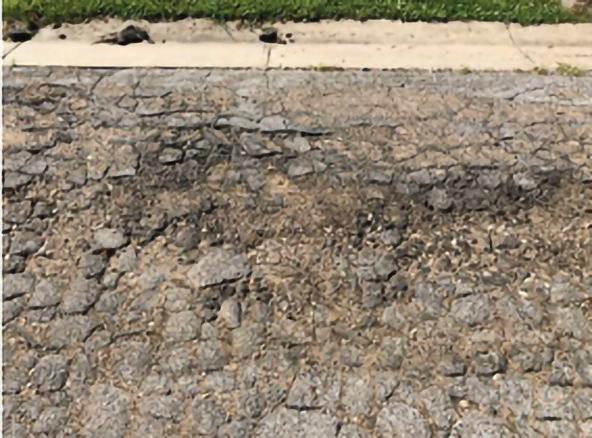
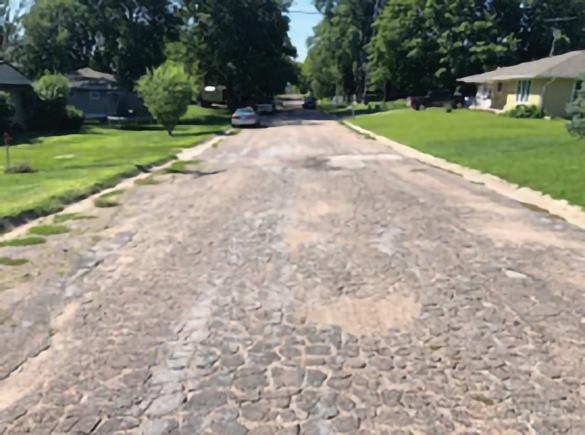
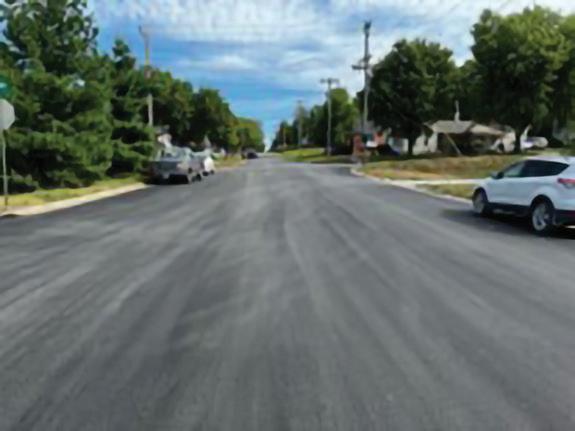
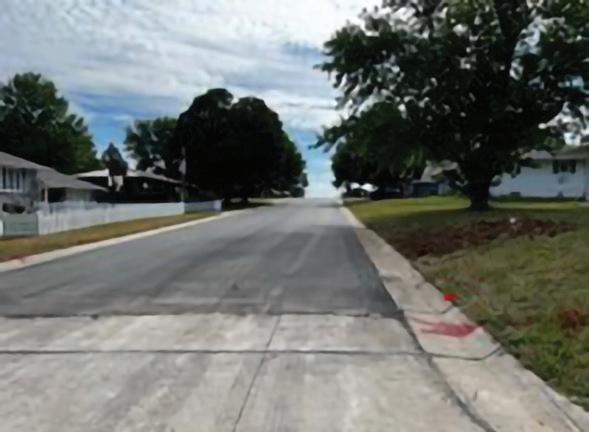

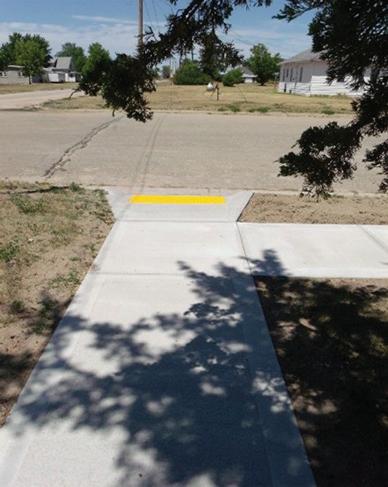
Sidewalk
Ask LNM
A sked Q uestions municipal
Topic: Filling Vacancies for Elected Officials

The League is often asked questions about how to fill vacancies for members of the city council, village board or mayor. Below are some of the most frequently asked questions.
My city council/village board member has resigned. What are the first steps?
LNM
State law requires vacancies in city and village elected offices to be filled by the mayor and council or chairperson and board of trustees for the balance of the unexpired term. The notice of a vacancy needs to be presented to the city council or village board at a regular or special meeting. The vacancy needs to appear as part of the minutes of the meeting.
Does the resignation have to be in writing?
LNM LNM
Yes. State law says the notice of vacancy, except a vacancy because of a death, needs to be in writing.
How does a municipality give notice of the vacancy?
The city council or village board is required to give notice of the vacancy “at once” after it is presented at the regular or special meeting. The notice can be published in a newspaper of general circulation within the city or village or by posting in three public places in the city or village. The notice needs to include the office vacated and the length of the unexpired term.
How long do I need to post the notice of the vacancy?
LNM
State law does not specify how long the notice needs to be posted. The League often tells municipalities they need to post for a reasonable period.
How long does the municipality have to fill the vacancy?
LNM
The meeting to fill the vacancy needs to happen within four weeks after the meeting at which the notice of vacancy is presented. This can sometimes be a challenge for village boards that only meet once a month. To meet the four-week deadline, a special meeting to fill the vacancy may need to be called.
What if more than half of my city council/village board positions are vacant?
LNM
LNM
If vacancies exist on the city council or village board of one-half or more, the Secretary of State steps in and conducts a special city election to fill the vacancies.
What happens at the meeting to fill the vacancy?
The mayor or chairperson of the village board places the issue of filling the vacancy on the agenda. The mayor or chairperson then submits the name of a qualified registered voter to fill the vacancy for the balance
of the unexpired term and the city council and village board votes. If a majority votes in favor of such nominee, the vacancy is declared filled. If the nominee fails to receive a majority of the votes, the nomination is rejected and the mayor or chairperson, at the next regular or special meeting, submits the name of another qualified registered voter to fill the vacancy. If the subsequent nominee fails to receive a majority of the votes, the mayor or chairperson continues at the same meeting to submit the names of qualified registered voters in nomination and the city council or village board continues to vote for the nominees until the vacancy is filled.
Does the appointed member have the same rights as an elected member?
LNM
Yes, the state law specifically states that any member of the city council or village board who has been appointed to fill a vacancy has the same rights, including voting, as if that person were elected.
Is there any other option for filling vacancies other than the one described above?
LNM
Yes. State law allows the mayor and council or chairperson and village board, in lieu of filling a vacancy as described above, to call a special municipal election to fill the vacancy.
What happens where there is a vacancy in the office of the mayor?
When there is a vacancy in the office of the mayor in a city of the first or second class, the president of the city council serves as mayor for the unexpired term.
As always, if you have additional questions about how to fill a vacancy, please consult with your municipal attorney.






